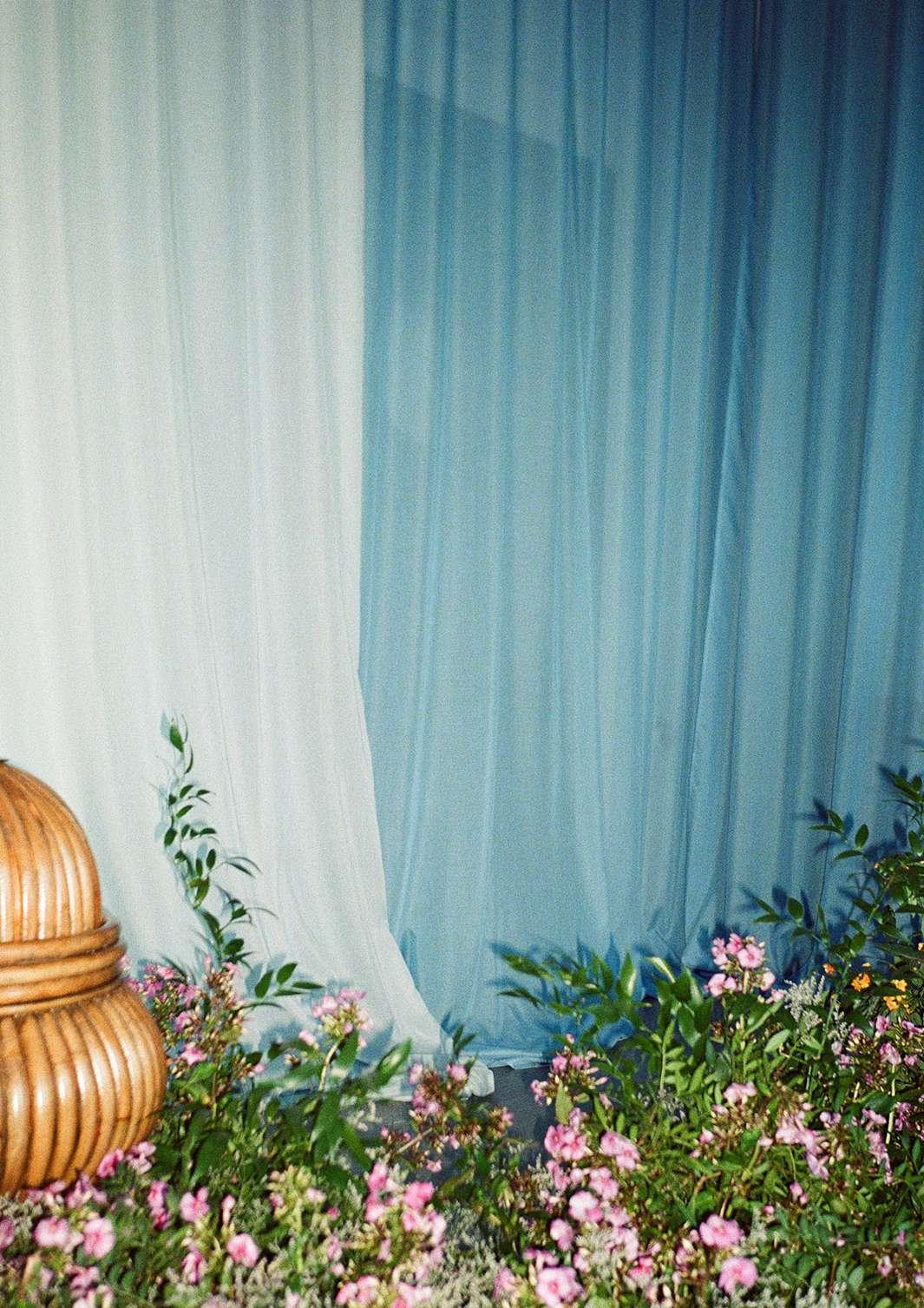GOES AL FRESCO







GUBI is venturing into the open air and breaking down the boundaries between inside and out. This new take on al fres co design features new collections from archival and con temporary designers, alongside outdoor versions of muchloved indoor classics. In the threshold spaces between inside and outside, iconic designers’ visions of la dolce vita come to life, with a refined bohemian aesthetic and a sense of celebration.
The divisions between inside and out have been blurring for decades, and today, there is a distinct global shift towards a more flexible approach to where we work, rest and play. Whereas once people wanted to ‘bring the outside in’ with biophilic interiors, or take the inside out by creating ‘outdoor rooms,’ now indoor and outdoor areas are merging to cre ate overlapping zones where the conventional distinctions between indoors and out are eroded. Such threshold spac es are no longer seen simply as welcome additions to our homes, but an integral part of them.
Today, more and more of us are investing in considered schemes that flow out onto a terrace or balcony, extending the usable square footage of our homes. Architecture flows outside to create ‘transteriors’ – half-way spaces of transition that are neither fully indoors nor entirely out. These might be
covered patios, sunrooms and conservatories, heated decks or greenhouses, pergolas strung with lights that draw the eye and create a convivial atmosphere, or even simple cano pies to gather beneath.
People are increasingly making design decisions that enable them to extend the amount of the day – and the year – that they can spend outside, investing in partially covered spaces that offer shade from the sun in the summer and protection from the elements in the shoulder seasons. There is an al most magical appeal about the night sky, some wild weath er, or a perfectly planted garden, enjoyed from the vantage point of low-level seating in a warm, comfortable space.
When moving outside, design lovers don’t leave their style or standards at the door – they prioritize the same aesthet ics and want all the same comforts of inside on the outside. Challenging the utilitarian focus of traditional outdoor furni ture, these new spaces demand the same aesthetic and er gonomic standards as indoor design. The humble barbecue grill teamed with a table and four chairs will no longer cut it.
As we move through, between, and within spaces, we want our design values to move with us. Outdoor spaces have ac quired the same importance to us as rooms within the house
– zoned into comfortable, well-equipped extensions of the home, providing for everything you might do inside, with aes thetic standards to match.
There is a space for every purpose and every time of day, from cozy single-person nooks to afternoon sun traps for lounging with family and friends, and from expansive dining areas with long generous tables to secluded breakfast spots perfectly positioned to catch the morning light just for the family.
Designed to move easily between indoor and outdoor spac es, GUBI’s new ‘transterior’ furniture and lighting includes the refined alternative-lifestyle aesthetic of Gabriella Cres pi’s Bohemian ’72 Collection, loved by the stars of stage and screen. GUBI adds dynamism to GamFratesi’s TS Table and Bill Curry’s innovative Obello Lamp, reinventing them as por table accessories that follow us wherever we go, bringing the look and feel of the indoors outside.
These transitional pieces are complemented by a selection of weatherproof options developed for year-round outdoor use. The low-level lounging embodied in Pierre Paulin’s sculptural Pacha Collection and the functional rigor of Marcel Gascoin’s C-Chair and F-Chair – now in teak – are reimagined for the outdoors. Out of production for decades, Mathieu Mategot’s
Tropique Collection is also back – its playful fringes and hammock-like seat and backrest perfect for poolside dining in the sun.
Statement pieces create interest and tell a story – and while a chandelier over the patio table might be impractical, adding portable table lamps or a striking piece of furniture is a simple way to elevate the atmosphere. You can create a bold and yet unified interior scheme that also encompasses the exterior – safe in the knowledge that everything has been optimized for outdoor use. You will even find outdoor-ready upholstery options to match your aesthetic taste.
From design classics converted for outdoor use to original design masters’ takes on al fresco living and contemporary additions to the collection, the newly expanded GUBI Col lection has been curated without compromise to embrace all spaces. Under a roof or open to the elements, you can have the best of GUBI wherever life takes you.
In the year that Italian designer Gabriella Crespi would have turned 100, and 50 years after its initial conception, GUBI is putting the Bohemian 72 Collection into production for the first time. The collection is the beginning of a new collaboration with Archivio Gabriella Crespi and reflects the harmony between Crespi’s artistic, bohemian vision and her love of travel and GUBI’s confident curations and global outlook.

Born in 1922, Italian artist and designer Gabriella Crespi would have turned 100 this year. Throughout her extraordinary ca reer in the design world, she moved effortlessly among both European royalty and the Hollywood jet set. Her indisputable glamour and sophisticated sense of style made her a muse to the fashion designer Valentino, and brought the likes of Au drey Hepburn, Gianni Versace, and Hubert de Givenchy into her social circle. As a designer, it was her gift for streamlined forms and lavish material finishes that won her a dedicated following and saw her become a coveted partner to presti gious fashion houses ranging from Dior to Stella McCartney.
Crespi’s aesthetic was characterized by dualities, pairing modernist functionality with an eye for the baroque, and shift ing between clean lines and sensuous curves. When she died

aged 95 in 2017, she left behind a repertoire of more than two thousand pieces, spanning furniture, jewelry, and sculpture – all imbued with an eclectic style that embraced both the organically whimsical and the formally geometric.
Crespi’s daughter Elisabetta Crespi now heads up Archivio Gabriella Crespi. “MymotherwasutterlyMilanese,” she says. “She had extraordinary taste, stemming from her inner pas sions and bohemian lifestyle. She was naturally elegant and didn’t follow mainstream fashion; instead, she favored a cul tivated simplicity in her aesthetic. She was modern, daring - almost radical in her propositions. From her innate allur ing qualities to the inviting furniture she designed, everything was sophisticated yet unconventional, with a warm, human, and sensuous feel to it.”


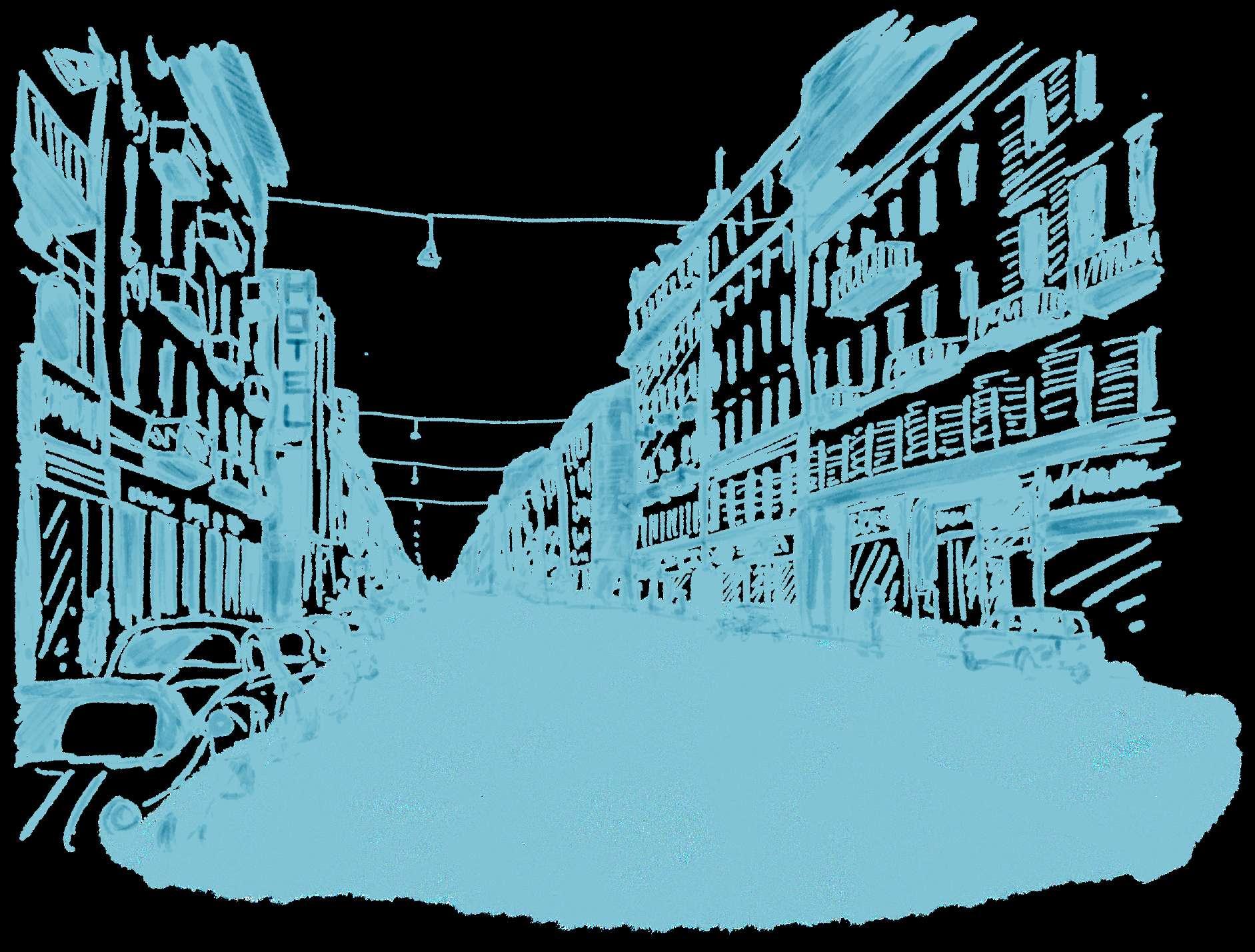

To honor the inspiring and extraordinary designer that Ga briella Crespi was, GUBI is proud to introduce the Bohemian 72 Collection. Elegant, flexible, and refined, this collection is the distillation of Crespi’s vision of a versatile rattan furniture family for what she called her ‘house of the sun’. The pinnacle of the jet-set bohemian lounge lifestyle, Bohemian 72 brings together Crespi’s interest in natural materials, her fascination with stacked sculptural forms, and her curiosity about Eastern cultures and philosophies, honed over years of travel.
During her lifetime, these exclusive pieces were only ever pro duced for private clients, but today, 50 years after they were first conceived, GUBI has worked from Crespi’s original draw ings to bring an extraordinary collection into production for the first time. In these iconic rattan furniture designs, a worldly Milanese sophistication is conjured from one of nature’s most humble-seeming materials.
Crespi designed the Bohemian 72 Collection in the spring of 1972 from the terrace of her home in Milan. Alongside the re nowned ‘Rising Sun’ and ‘Five Positions’ Collections, Bohe mian 72 was part of Crespi’s wider ‘Bamboo Collection’, de signed between 1972 and 1975. Comprising a lounge chair, three-seater sofa, ottoman and floor lamp, the collection is the culmination of Crespi’s career-long mission to create furniture that seamlessly unites indoor and outdoor living.
Drawn to rattan for its strength and versatility, she conceived these pieces at a time when the material was very much in vogue within the high-society circles in which she moved, viewed as the height of interior sophistication. Her deci sion to use repeating layers of vertically coiled rattan vines, however, was unusual for the time, and results in a distinctive and highly luxurious take on lounge furniture that has proven truly timeless.
Crespi’s goal was to create a flexible rattan seating collec tion that felt equally at home in the city or the country, at the seaside or high on a mountain slope. Her great ambi tion, she once said, was to create ‘a house of the sun’ – an environment that radiated warmth, light and sophistication. Rattan, with its gentle tones, natural appearance and the way light passes between its canes, is the perfect material to create such a setting.
“I wanted to create the house of the sun,” she said. “I couldn’t help but do it with rattan and bamboo, materials of whichI’mveryfondandthatcombinestrengthandflexibility, thewarmthofmellowtones,andtheabilitytoberunthrough by light. Very long spokes give an impression of the infinite and indeterminate just as cane thickets that rise toward the sky do in nature.”
To recreate Crespi’s original designs demands a high lev el of craftsmanship, as the rattan canes must be steamed and then bent by hand around a die, specially made to the dimensions of her drawings. Because it is a natural material, standardizing rattan is a complex process, and color, texture and dimension differ from vine to vine, introducing another level of skill to the production process.
Bohemian 72 Floor Lamp Bohemian 72 Lounge Chair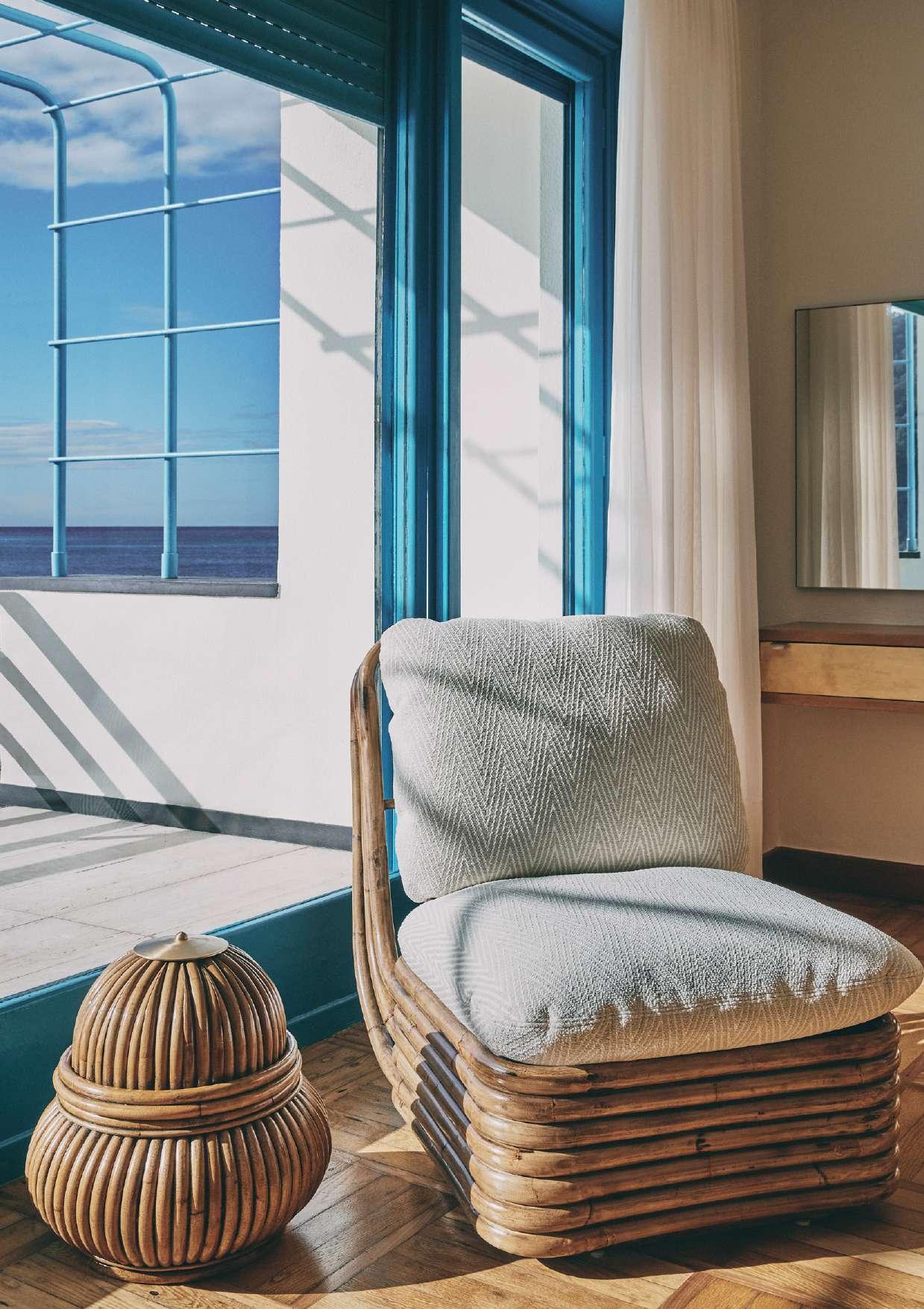

Each of the seats is topped with a lavishly plump cushion that follows the outline of the rattan frame perfectly, based on Crespi’s original drawings. Sleek in form but supremely soft, they introduce a cosseting level of com fort to the collection. This near-decadent focus on indulgence is empha sized in the backrest of the lounge chair, which has a generous 115º incline to encourage even deeper relaxation.

The floor lamp has a shade formed from a vertical arrangement of rattan strips, with brass detailing. The pattern of the strips allows the lamp to cast a beautifully delicate play of light and shade on the floor around it, evok ing an atmosphere of rustic warmth and bohemian sophistication. In all four pieces, the bent rattan canes and strips are stained with antique color and finished with a gloss coating to ensure a consistent appearance and a rich and warming natural texture. Each member of the collection can stand proudly on its own, but taken as an ensemble, the quartet makes a timeless statement of luxury.
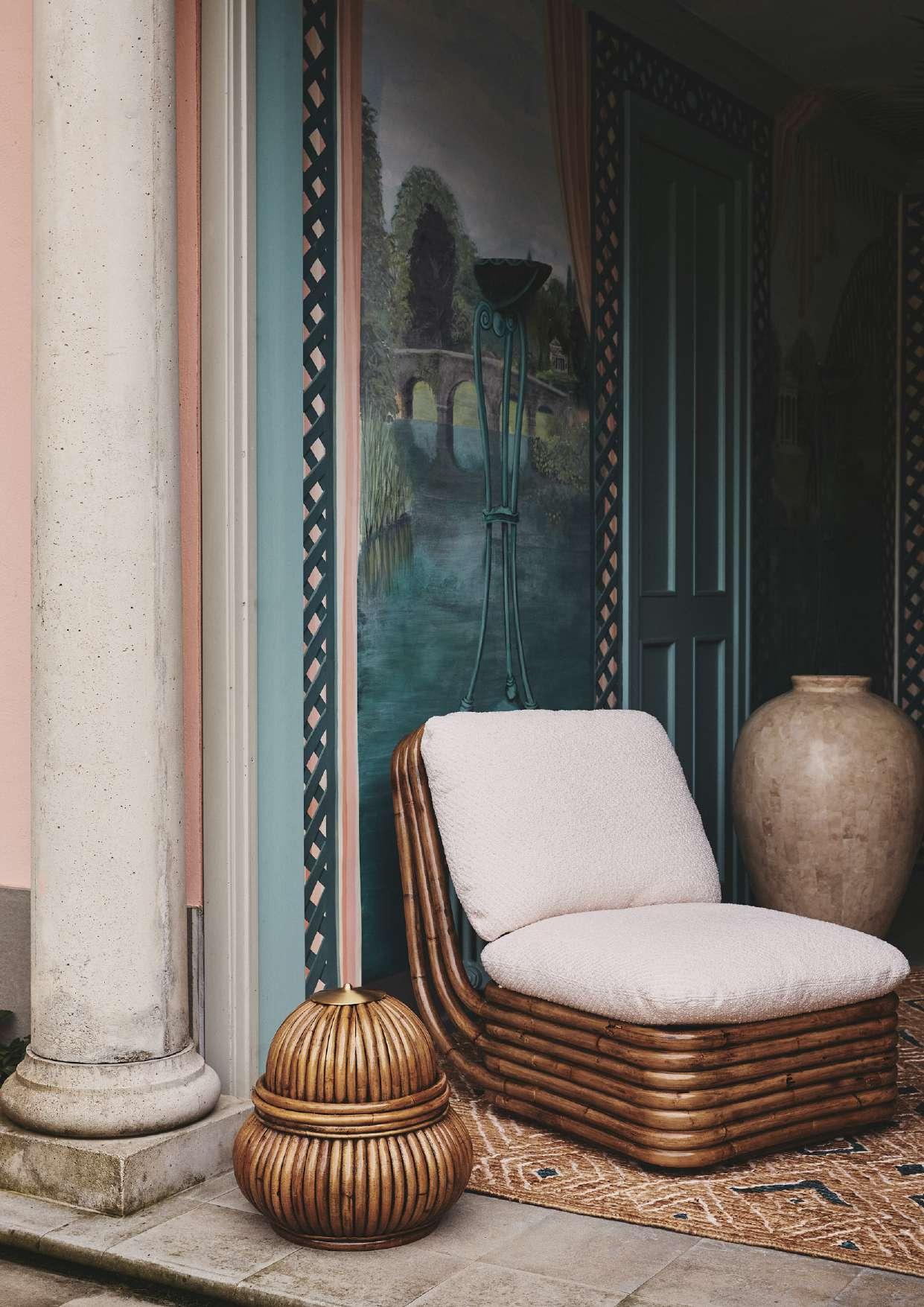
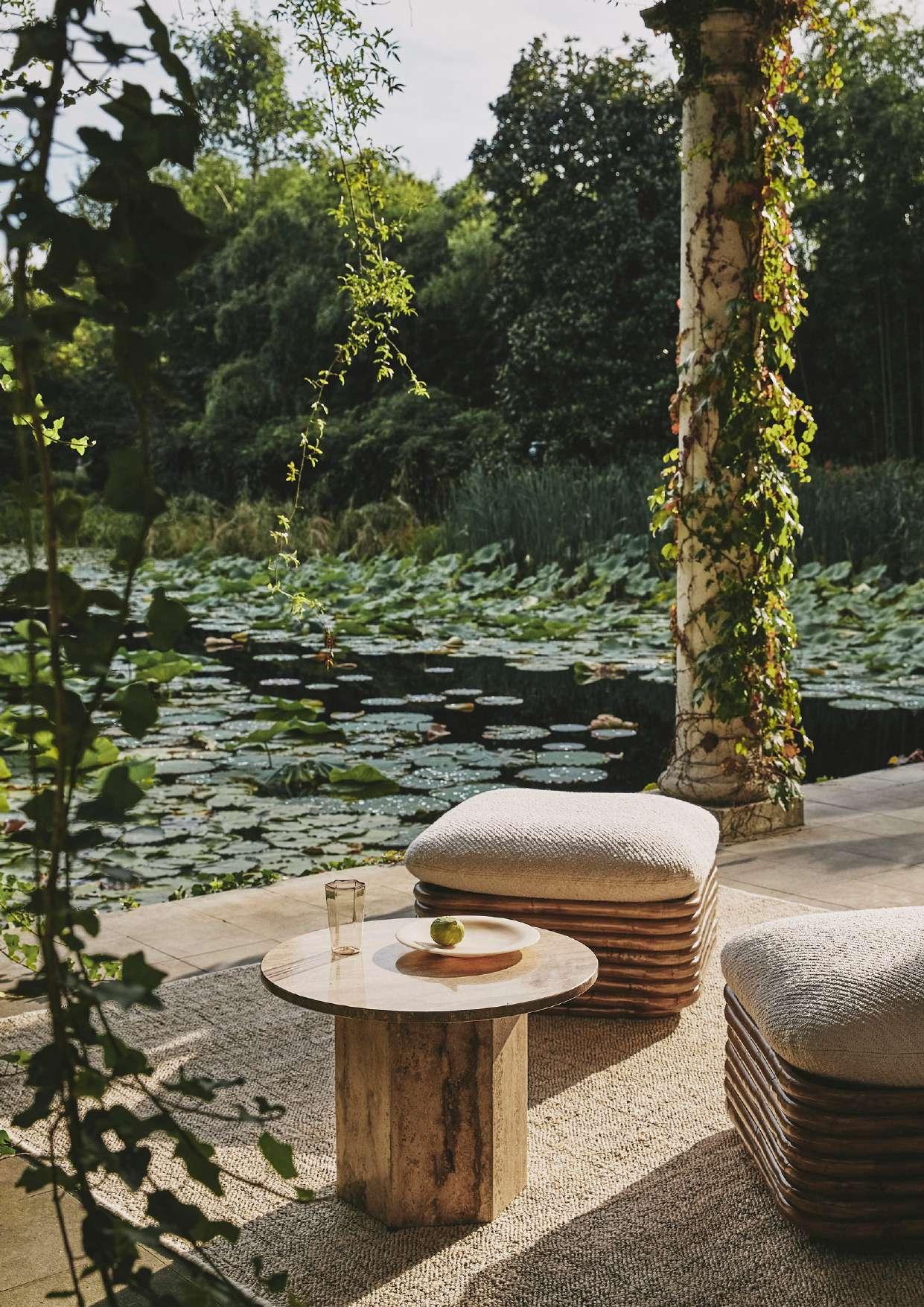
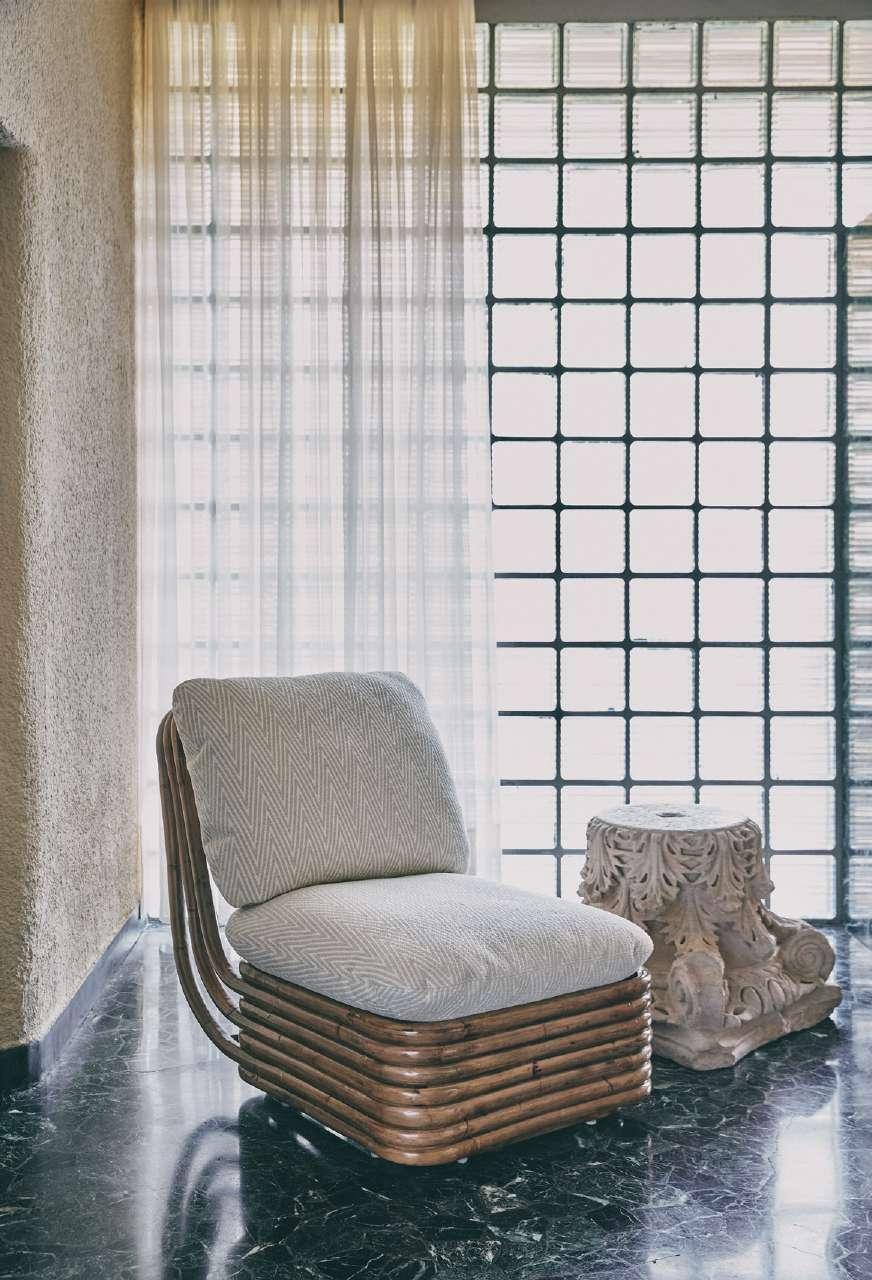
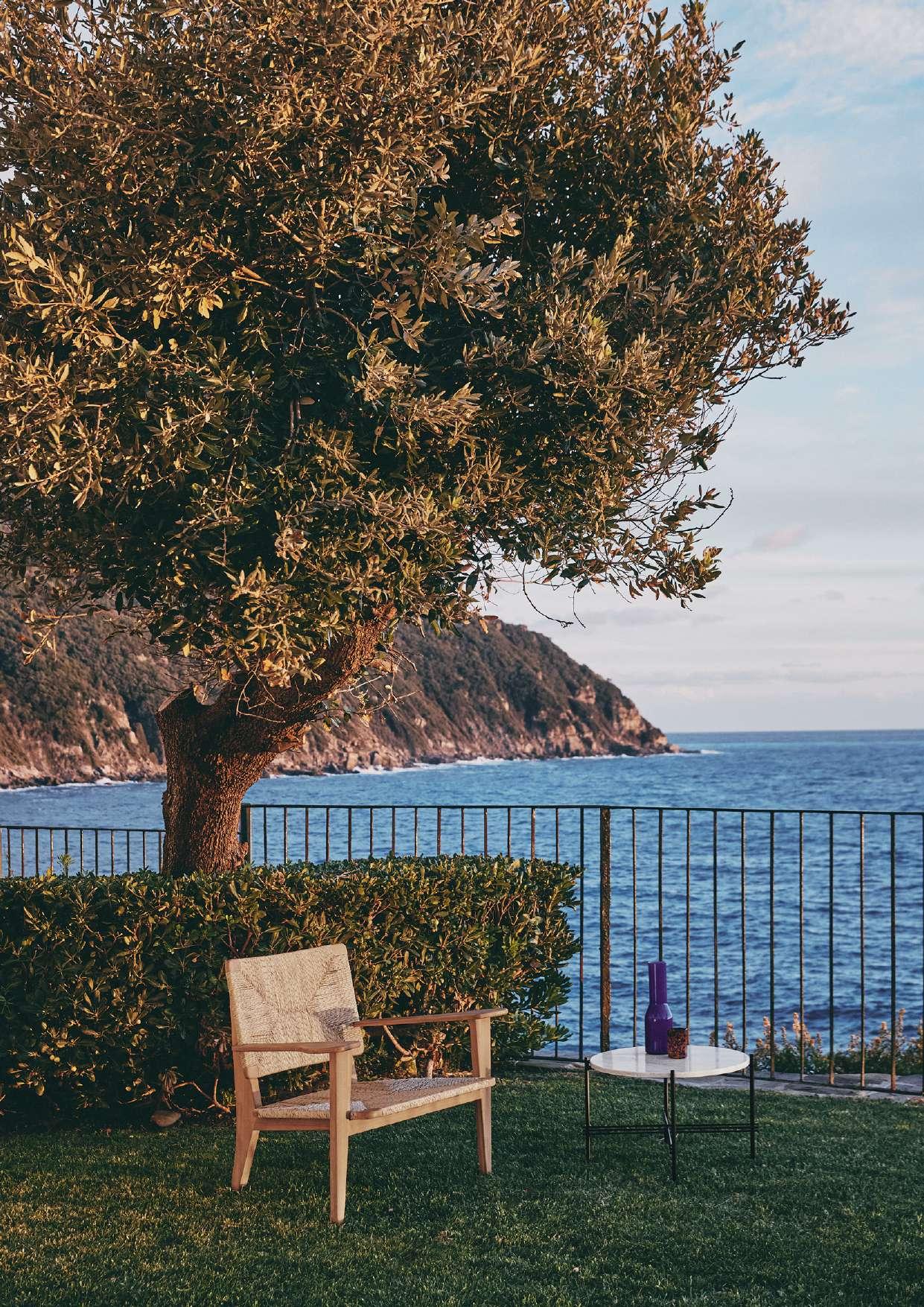

French designer Marcel Gascoin (1907-1986) was one of the leading furniture designers of the post-war era. He is recognized for the vital role he played in the reconstruction of France after the Second World War, when his pragmatic modular storage units and matching sets of wooden furniture, which focused on clean aesthetics and functionality, became a staple for French households.



During the post-war housing crisis in France, Gascoin worked as an interior architect and designer for the French Ministry of Reconstruction and Urbanism, designing homes as well as the furniture to go inside them. He drew on his long-held love of wood, his childhood fascination with com pact and efficient nautical interiors, and his training as an interior designer and cabinetmaker to create a new standard for furniture that was rational and utilitarian.

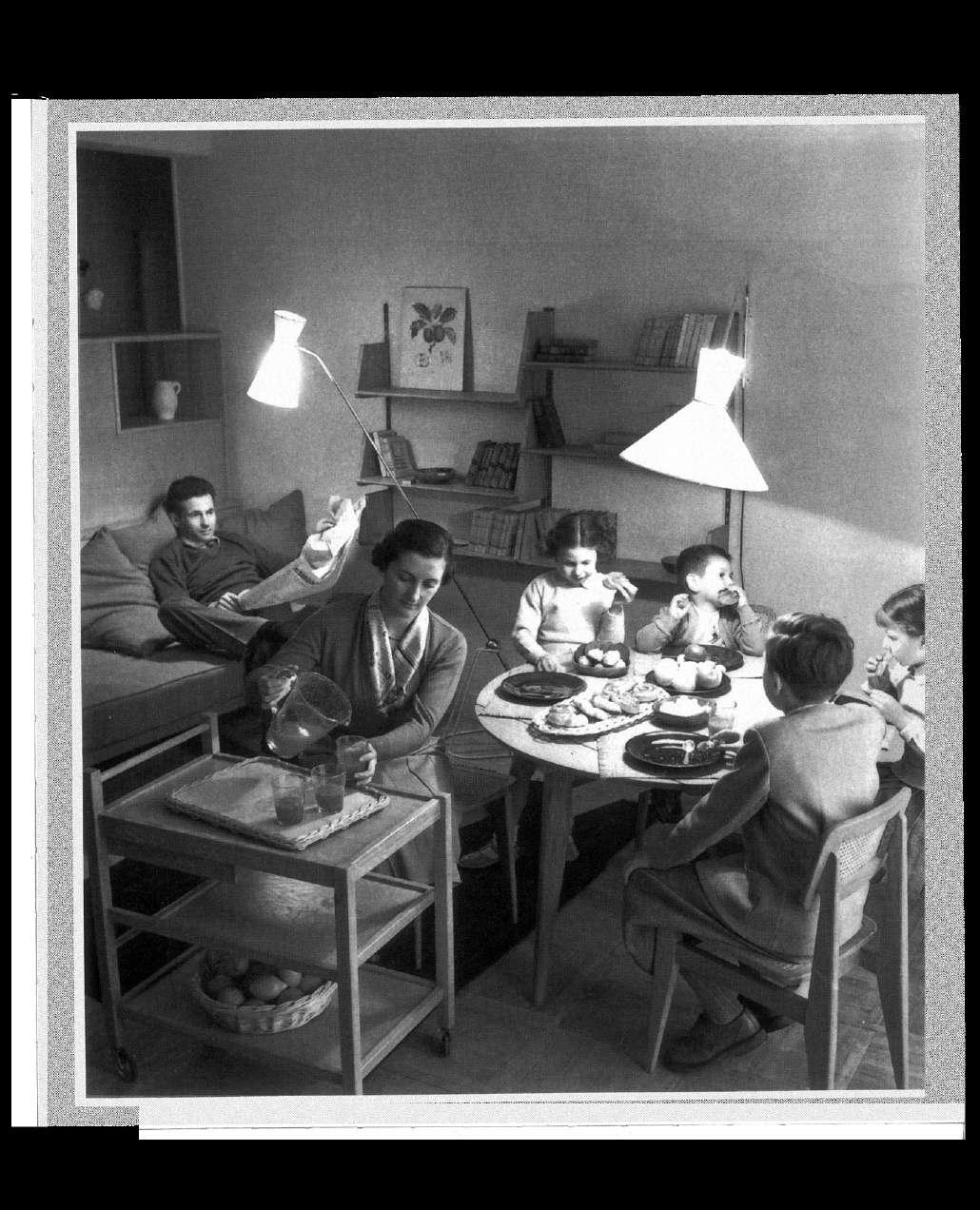
The new concept of a “living-room” (pièce à vivre) was launched at the “Logis 49” fair in Paris, combining two tradi tionally separate spaces for dining and resting or “living” and placing the kitchen nearby. Forward-thinking for its time, and driven by a strong social conscience, Gascoin’s democratic design connected art and industry, bringing together clean aesthetics, efficient manufacturing processes and common sense to create some of the first modular and multifunction al furniture sets. They balanced utility with elegance, used coherent design to enable affordability, and have been de scribed as “a model of modernity”.
Gascoin was a member of the UAM (L’Union des Artistes Modernes or the French Union of Modern Artists) alongside important modernist designers such as Robert Mallet-Ste vens, Charlotte Perriand, Jean Prouvé, Mathieu Martégot, Eileen Gray, René Herbst and Le Corbusier. This was an in tellectual movement bound by a philosophy of design that united function with fabrication. In his own workshop, he passed his knowledge on to the next generation of interior decorators and furniture designers, and several of Gascoin’s apprentices, such as Michel Mortier, Pierre Paulin and Jo seph-André Motte, went on to have distinguished careers as designers in their own right.
Today, Gascoin’s work is being re-discovered by collectors, curators and designers across the globe, all of whom ad mire his quietly revolutionary approach to design. For the new Gascoin Outdoor Collection, Marcel Gascoin's nautical upbringing inspired the combination of teak and woven cord, a perfect material choice for high-quality exterior furniture.
The garden gets an upgrade with the simple functionality of two of Marcel Gascoin’s most enduring iconic designs. GU BI’s new outdoor collection, now in teak, represents significant innovation for Gascoin’s iconic design, adapting the C-Chair for al fresco mealtimes, and adding a new lounge typology to GUBI’s collection.
A new outdoor version of the much-loved C-Chair – a din ing chair originally designed in 1947 for post-war housing in France – is joined outside by a little-known Gascoin gem, the F-Chair. The more relaxed incline and paddle-shaped arm rests, together with its woven seat which widens at the front, make the F-Chair an altogether more leisurely affair.

This rarely seen design made its first appearance in 1949 at the traveling exhibition ‘Maison Rurale’, which set out to showcase furniture that met the particular needs of life in the countryside. However, it was never produced at scale, and original exam ples are rarities today.

Both the C-Chair and the F-Chair are optimized for the out doors in both their ergonomics and their materiality. Propor tions have been fine-tuned to maximize comfort and frames have been carefully crafted with traditional joinery using plan tation teak. The seats and backrests are tightly woven from an outdoor all-weather fiber made of an extruded polyethylene and twisted to resemble natural hyacinth woven furniture. The weave pattern creates triangle shapes from all four sides of the seat and backrest, converging at the center of each like an envelope. The woven cord captures the natural look of the indoor version, while being durable enough to withstand the elements outside.
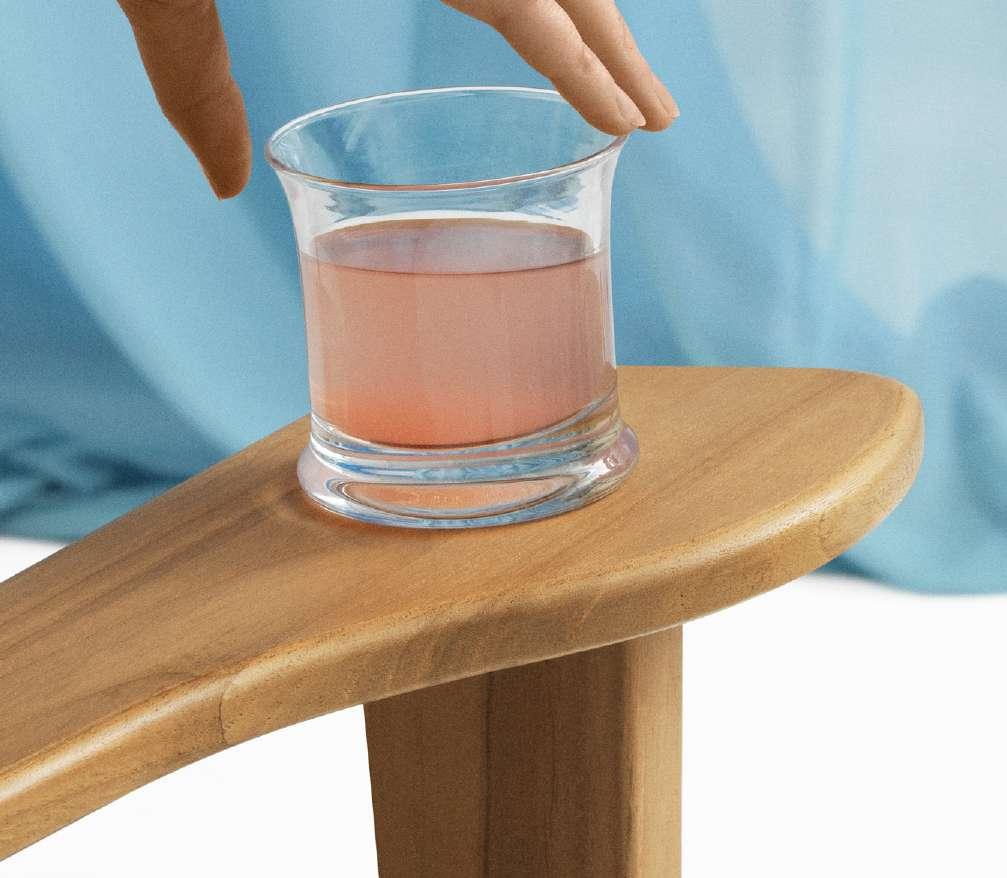
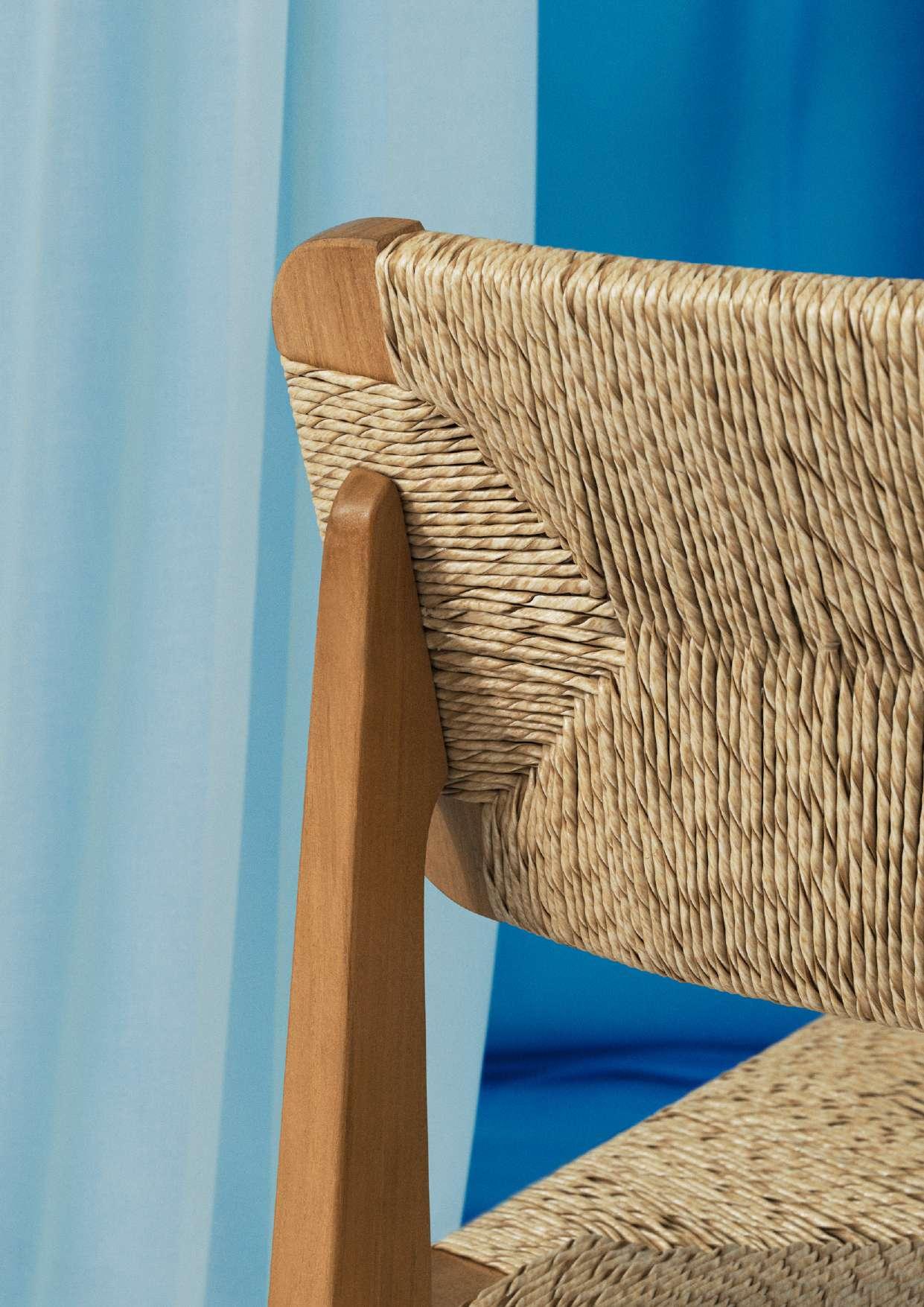
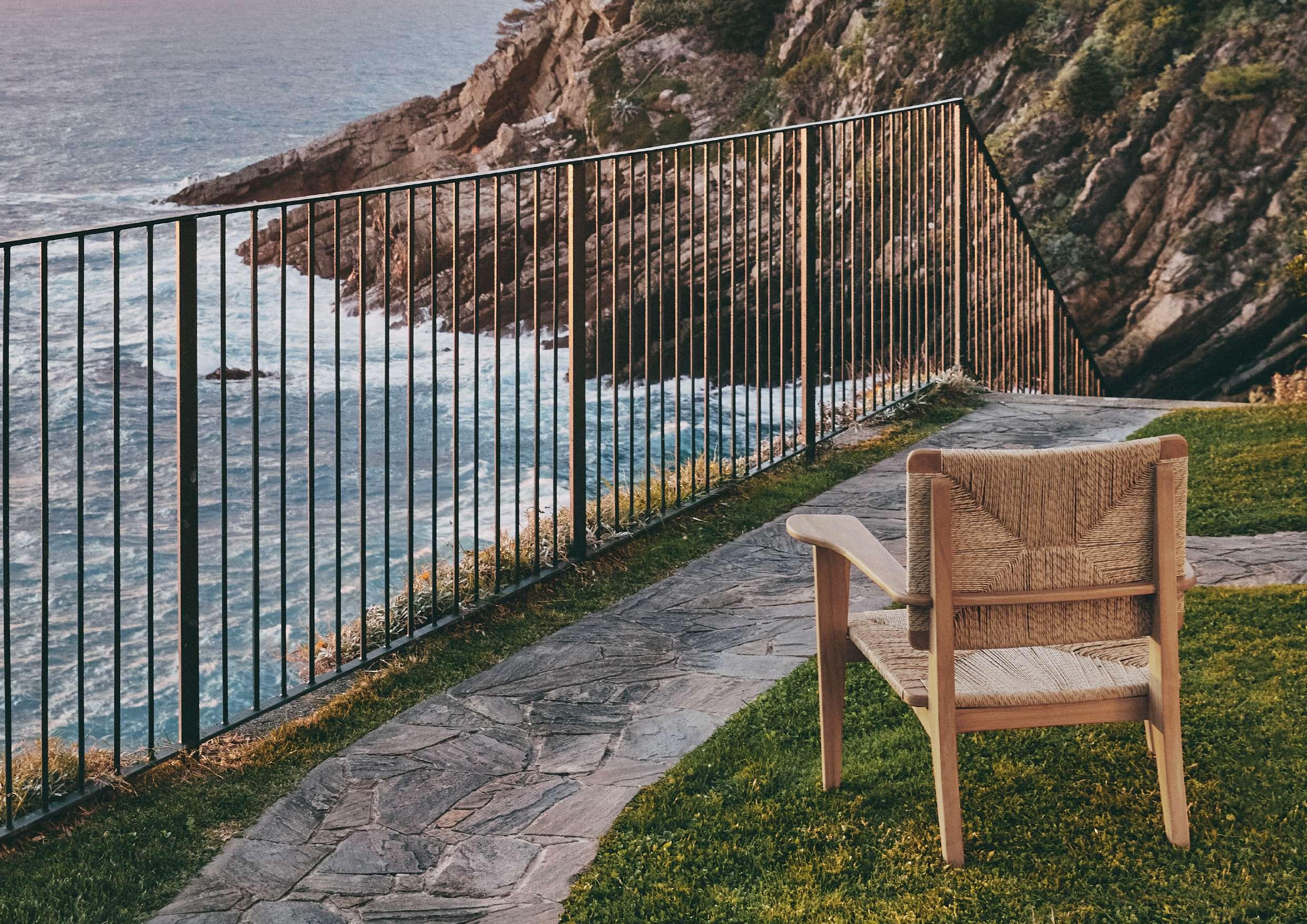

American designer Bill Curry (1927-1971) captured the zeitgeist of the 1960s and ‘70s with his iconic lamp designs. From his unique Los Angeles vantage point at the meeting point of art, design and engineering, during an era defined by the space race, pop culture and a new forward-looking optimism, he translated the wonder and delight he saw around him into simple yet intelligent ideas with clear visual narratives. Credited with developing the first ‘total look’ lamp forms –eliminating the base-bulb-shade concept and instead exploiting the bare bulb in a playful, self-contained unit – he was recognized as one of California’s leading designers by the time he died at the age of just 43.


exposure to pioneering developments in electronics and sys tems engineering in the aerospace industry gave Curry the experience and confidence to venture into industrial design and launch his own home furnishings company, Design Line Inc., in 1962.
From the first human-made object touching the lunar sur face in 1959 to Neil Armstrong’s first steps on the Moon in 1969, the era was dubbed the ‘space age’ and its aesthet ics influenced a generation. At the same time, the miniskirt moved from science fiction films to the high street, popu larized by designers such as Mary Quant, and a new gen eration of Disney artists turned Mickey Mouse into a global icon: pop culture was born. The modernism that had char acterized American architecture since the 1930s evolved into a futuristic style influenced by the space race as well

as emerging car culture, jet engines, pop trends, and the ‘Atomic Age’. From his beach house in Playa del Rey, Curry watched the jets flying over Los Angeles Airport and, imag ined a future shaped by new technologies.
He absorbed all these influences and ideas to develop a new norm for lighting – a single piece that combined stand, bulb and shade into one organic, yet bold and colorful ‘LA spacepop’ form, fit for tomorrow’s world. He contrasted colorful cast-iron bases with transparent glass tops, and combined interrelated materials, parts and colors across multiple prod ucts. His space-age ‘total look’ lamps were an instant hit – Industrial Design Magazine awarded his collection the accolade of ‘Best Lamps of the Year’ and the US Depart ment of Commerce showcased his Stemlite Collection in the Soviet Union, Yugoslavia, and Iraq, as exemplars of American design.

By 1969, with more than 50 national design awards, includ ing the New York Art Directors Club’s Award of Distinctive Merit, to his name, Curry was described by the Los Angeles Times as “one of California’s leading designers” just before his untimely death two years later. His legacy lives on today as one of the true pioneers of American space-age design.
Bill Curry designed the Obello Lamp in 1971. Using the visu al form of a mushroom, he took inspiration from the atomic age, space race, and pop culture that would go on to define 1970s Los Angeles. Sadly, he passed away the same year, and never saw the Obello Lamp go into production – in fact it was at such an early prototype phase that he hadn’t even given it a name.

Half a century later, with the endorsement of his family, GUBI has put Curry’s innovative design into production for the first time, now as a portable version. With a frosted, mouth-blown glass shade, as used for Curry’s original lamps, and integrat ed dimmable-LED light source, the rechargeable lamp can easily be moved between inside and out. With a complete charge in four and a half hours, providing up to 40 hours of light, Obello will create a cozy atmosphere as the sun starts to set and last well into the night. The Obello Lamp is an icon ic space-age design that will make a strong statement, either as a playful center piece or a point of curiosity within any outdoor space.
Let the Obello Lamp light up your interior or pick it up and carry it outside to create the sense of an ‘outdoor room.’ The shade is made from mouth-blown glass – a challenge given its shape – as a nod to old petroleum lanterns, and the por table size makes it easy to carry. This materiality and crafts
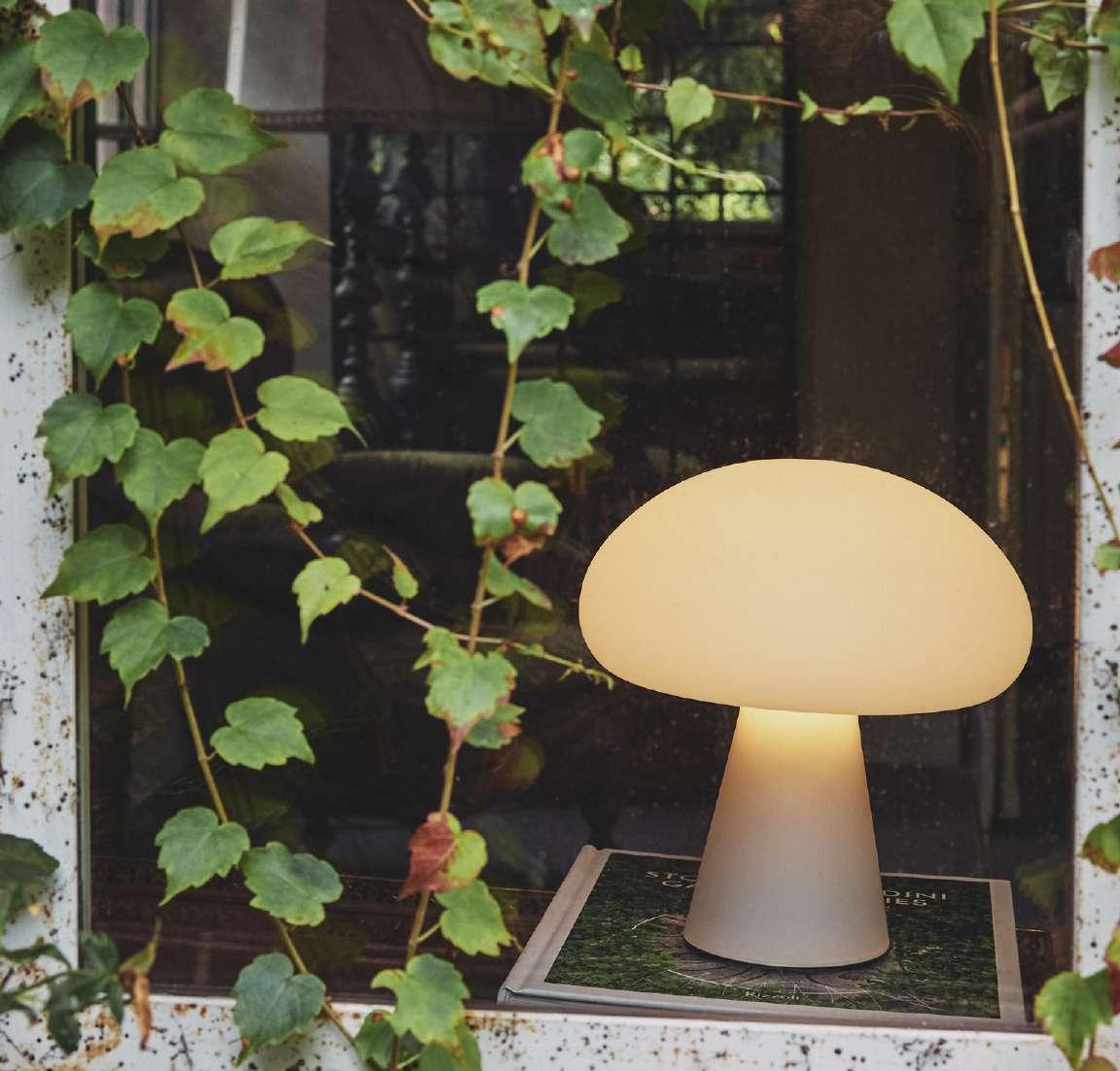

manship adds value and tactility, making each lamp unique. The dimmer switch means it can be turned up as the sun goes down to extend the evening beyond dusk. Its soft glow is created by two LEDs, a brighter bulb one facing upwards, and a dimmer bulb facing downwards into the lamp’s stem. The integrated dual-output LED and frosted shade ensure an even light distribution and the same look from all angles. While the lamp should be stored and charged indoors, it is splash-proof and so will withstand the odd rainshower, as well as sand and soil. If you’re happy to be outside – so is the Obello.
The Obello Lamp is being relaunched as part of GUBI’s mis sion to reintroduce Bill Curry’s work to contemporary audi ences, securing his place in the design pantheon. Its striking form, flexible functionality and quality craftsmanship make it an ideal addition to the GUBI Collection.
Obello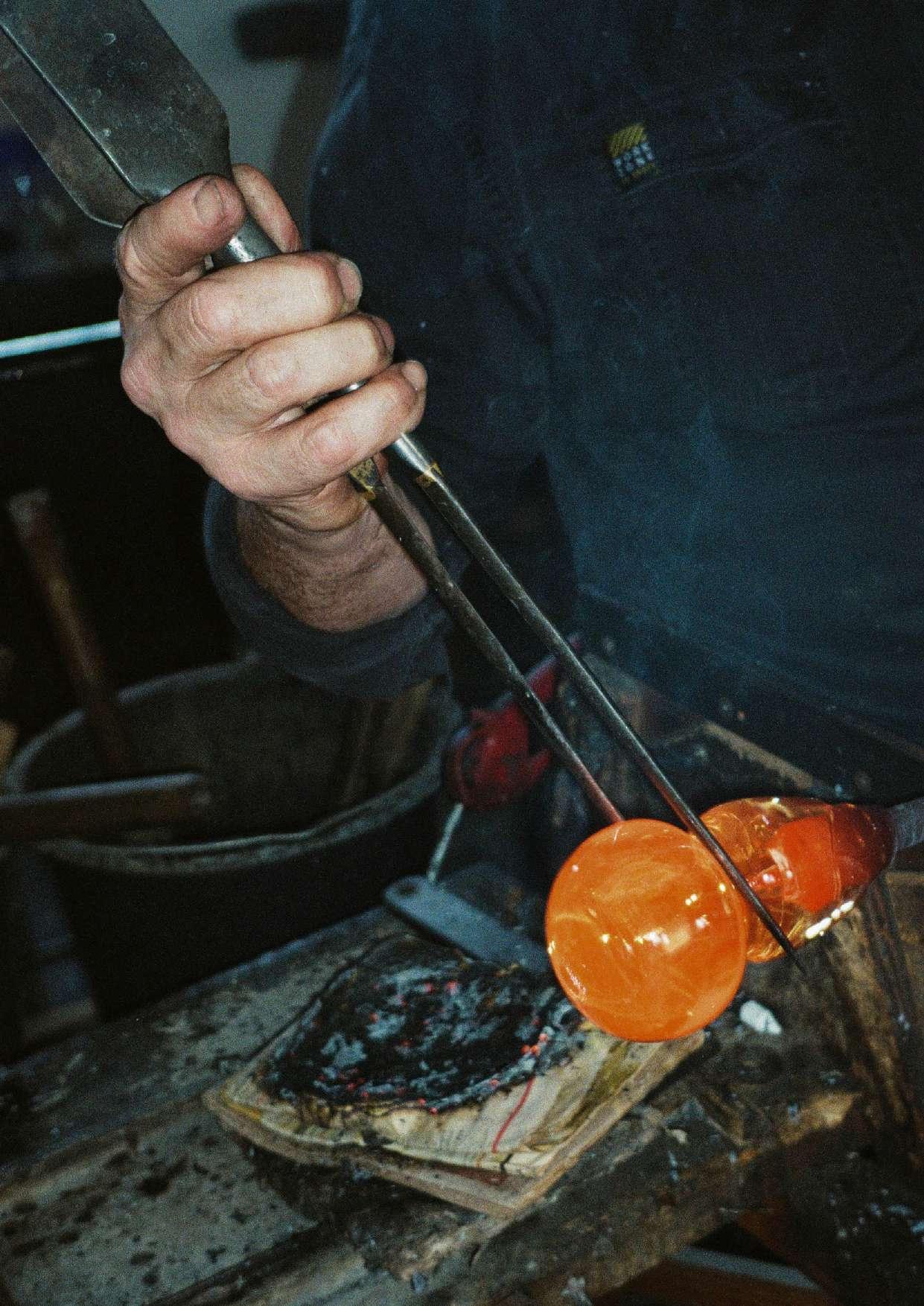

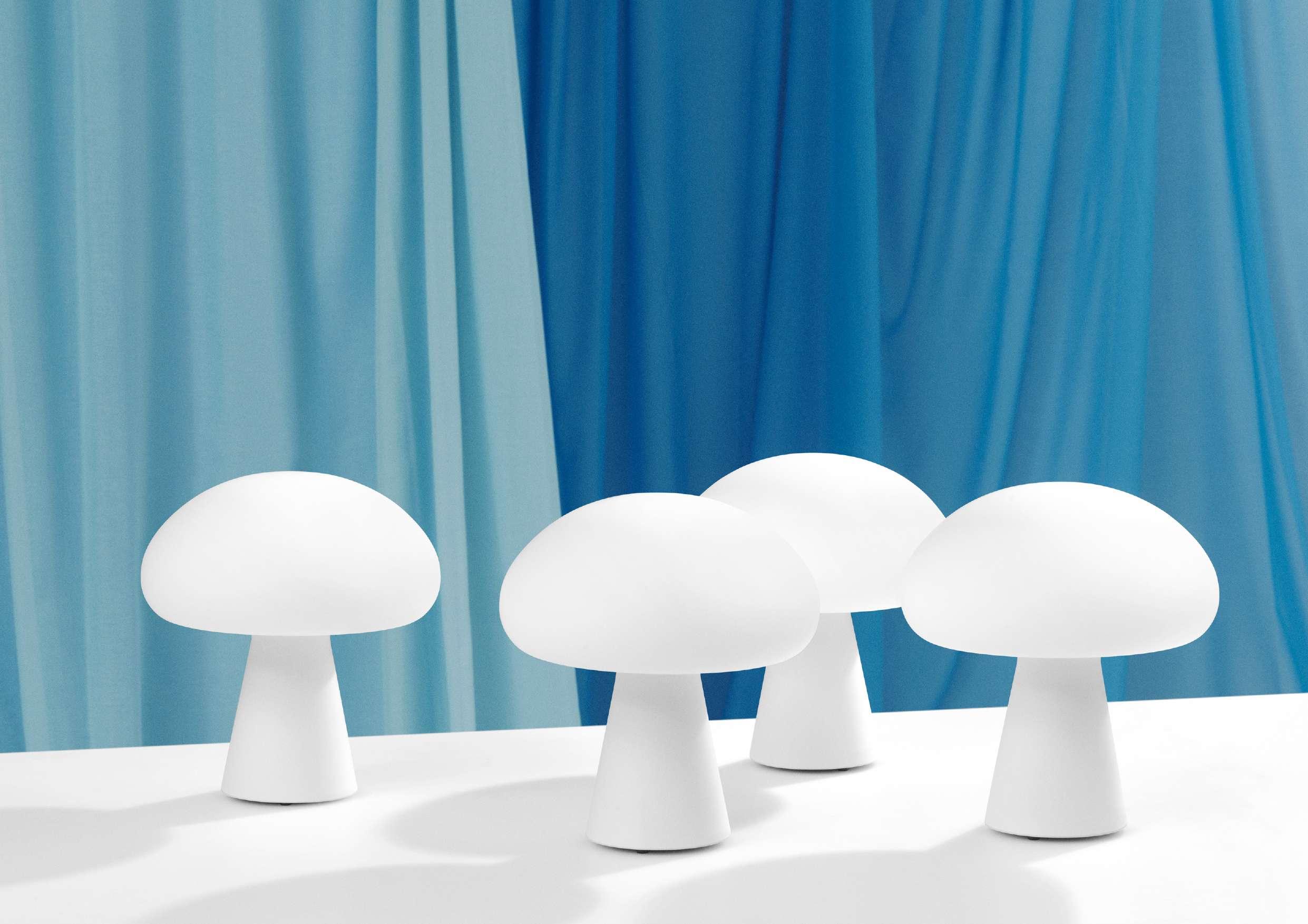




GamFratesi was established in Copenhagen in 2006 by Danish architect Stine Gam (born 1975) and her partner, Italian architect Enrico Fratesi (born 1978). Gam studied at the school of architecture in Aarhus, Denmark, before training and working as an architect in both Italy and Tokyo. Fratesi read architecture at universities in Florence and Ferrara and worked as an architect in Stockholm and Denmark while still studying. As a pair, they operate in symbiosis, sharing everything across their personal and professional lives. Gam takes a particular and thoughtful approach to design, while Fratesi moves more conceptually and energetically. This instinctive and spontaneous fusion of two ways of working is one of their key strengths.

The TS Collection is already well known and appreciated among design lovers for its ability to suit any interior and setting. Now, the black-based TS Side and Coffee Tables are getting the outdoor treatment. The luxurious ta bletops, in beautifully veined white travertine, complement the sharp, geo metric bases in powder-coated stainless steel, and enable the collection’s stylish interior aesthetic to cross the threshold into the open air.
The TS Collection for outdoor, offered in two sizes, creates a sophisticated and sculptural statement with its characteristic slender legs, crossing de tails and contrasting solid tabletop. It was designed in 2014 by GamFratesi for renowned restaurant The Standard in Copenhagen, from which it takes not only its name, but also its aesthetics and material inspiration.

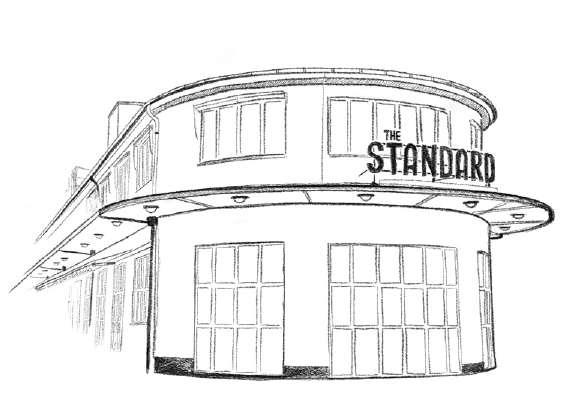

Brought together with exceptional quality and craftsmanship, the TS Col lection is a friendly combination of classic and contemporary lines – the fundamental characteristics of the GUBI Collection. The tables can be both practical and playful, creating different expressions with varying functions, depending on the sizes and number of tables combined.
An understated colorway that lets the texture of the stone take centerstage, the Neutral White travertine and black frame is the minimalist option, per fect for a calm, quiet space or as a moment’s pause. The tables also com bine well with the chairs and other seating in the outdoor GUBI Collection.
The use of a matched-color marble and cement solution to fill the naturally occurring crevasses in the travertine results in a durable surface able to withstand the elements that is easily cleaned with a soft cloth. As a natural material, the stone will gain a beautiful patina over time. Their stainless-steel base, with the added protection of powder coating, means that the tables can be left outside, but they should be brought inside in case of extreme heat or frosts to prevent damage caused by thermal shock.
GamFratesi has been working with GUBI since the inception of their studio. With their own dual heritage, Italian Enrico Fratesi and Danish Stine Gam share GUBI’s ability to syn thesize seemingly opposing ideas – the classic and the con temporary, the intellectual and the sensual, the understated and the expressive, the manufactured and the unique. This alluring combination of styles is perfectly embodied in the TS Collection for both indoor and outdoor usage.
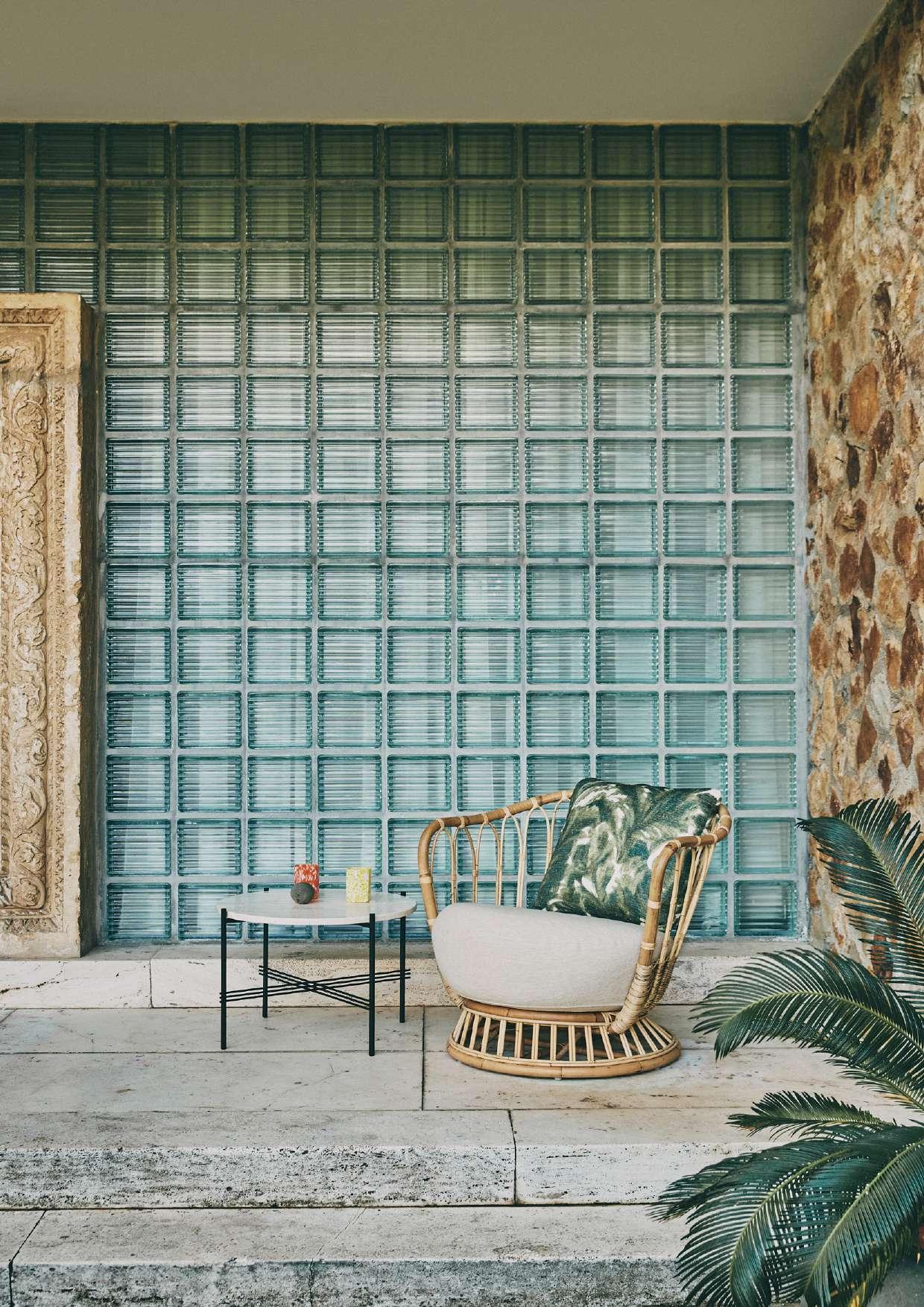
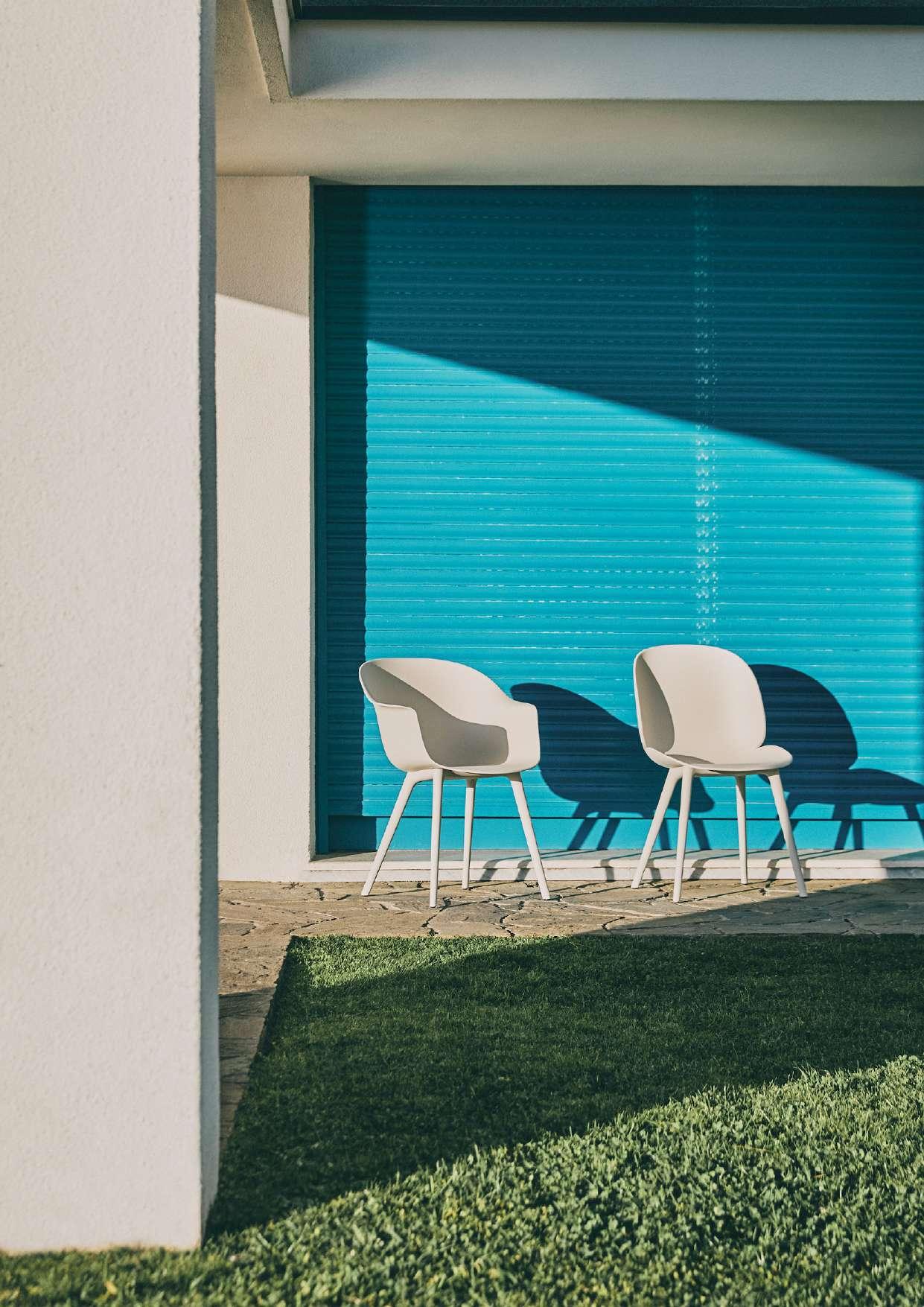
Inspired by the forms of nature, the Bat and Beetle Dining Chairs by GamFratesi are among GUBI’s most celebrated fur niture designs. These specially developed outdoor editions are tailor-made for al fresco living, breaking down the barriers be tween indoors and outdoors and taking the iconic designs into a new dimension.
“The Beetle and Bat Chairs are two of the most complex proj ects we have ever undertaken. Their free, organic yet precise lines are what make them unique,” says designer Stine Gam. “Both were inspired by nature, so we are delighted that they can also be used outdoors and thus return to their natural hab itat,” adds Enrico Fratesi.
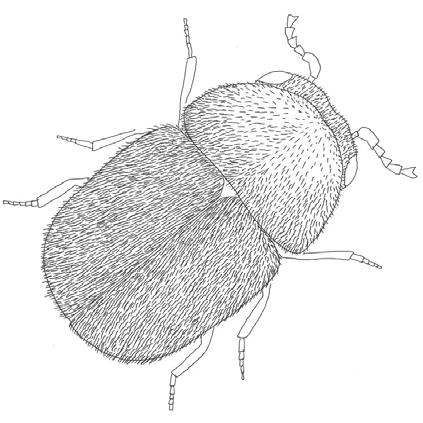

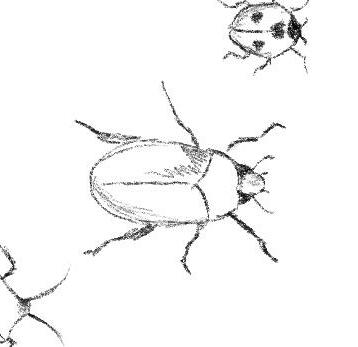


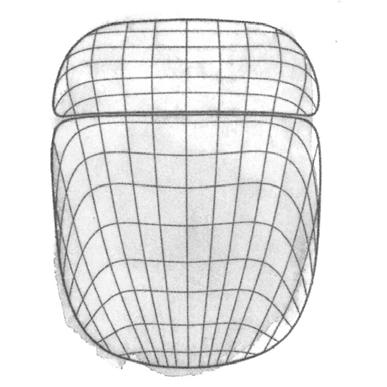

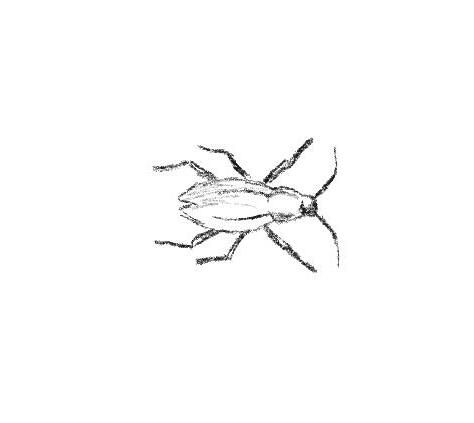


The Beetle and Bat outdoor editions imbue their elegant lines with an informality and lightness appropriate to the outdoor setting. Both find design inspiration in the natural world. The Beetle Dining Chair is designed both to be robust and to gen tly flex in response to micro-movements, echoing the com plex movements a beetle can make while keeping its body parts rigid and defined. The organic shape and gentle curves of the Bat Dining Chair are a three-dimensional reflection of the webbed wings of the animal that inspired it, with the front, arm and backrest forming a single continuous line when viewed from above.
O FAlthough the chairs are still perfectly suitable for indoor use, GamFratesi has modified the designs to ensure they are also optimized for exterior settings. Pushing the boundaries of ther moplastic technology, the chairs’ curved outer shells benefit from the addition of a UV additive. This strengthens the poly propylene, preventing the two colors – New Beige and Alabas ter White – from fading due to weather damage, thus making two already versatile chairs even more dynamic. A matt-satin finish gives both chairs an engaging tactility, while their light weight enables both to be easily moved, further blurring the frontiers between internal and external spaces.
Like the indoor editions, each piece in the Beetle and Bat Out door Collection is designed for disassembly and fully recycla ble. The optional seat cushion is upholstered in outdoor-appro priate fabric and is equally suited to use on the Beetle and the Bat, without any rigid fittings or fixings. Taking inspiration from the branching form of a tree, the conical legs of both chairs seamlessly integrate with the structure under the seat. In this way, the chairs are functionally and aesthetically adapted for outdoor spaces, while preserving the qualities and values of their indoor counterparts.
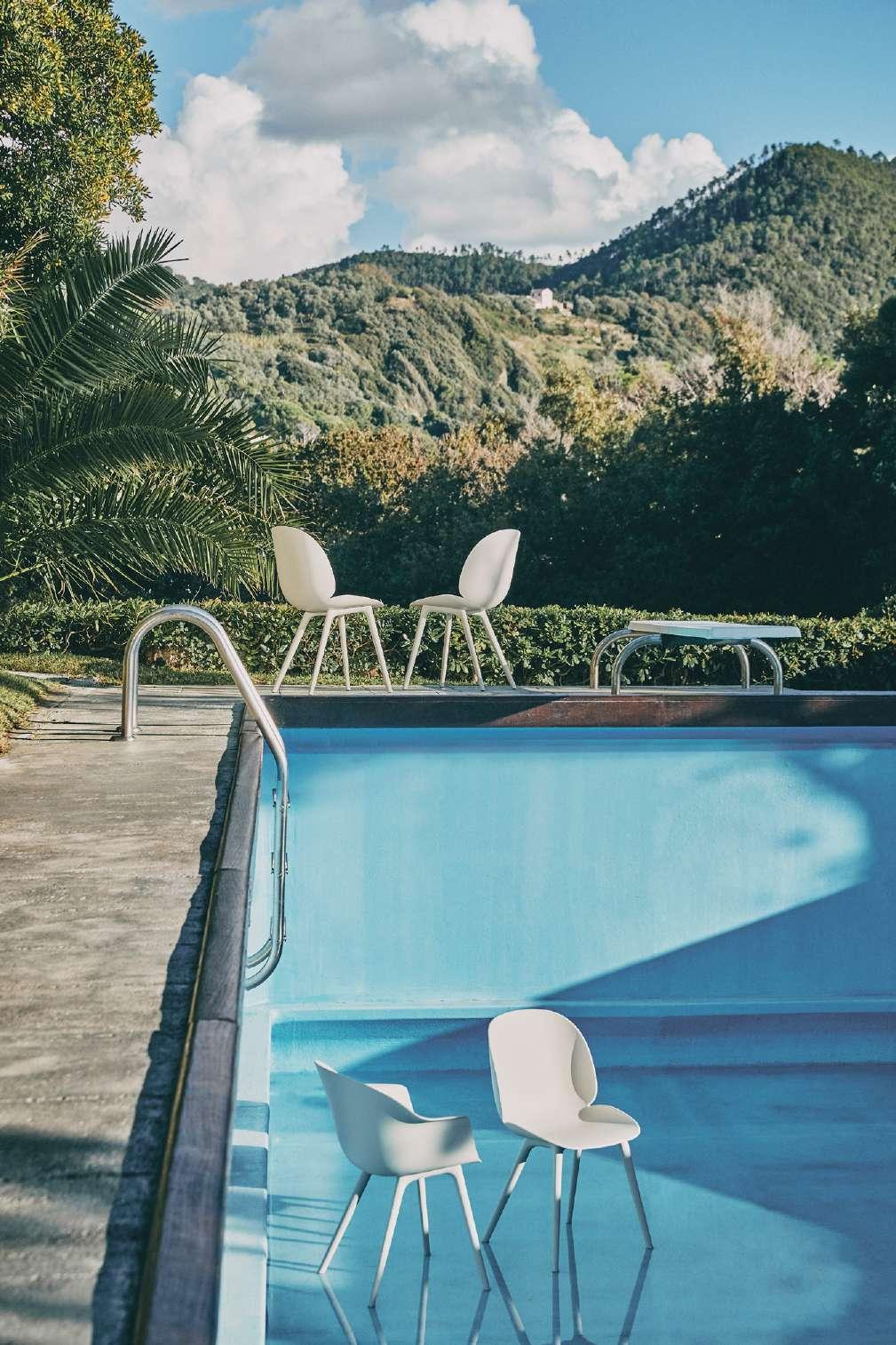
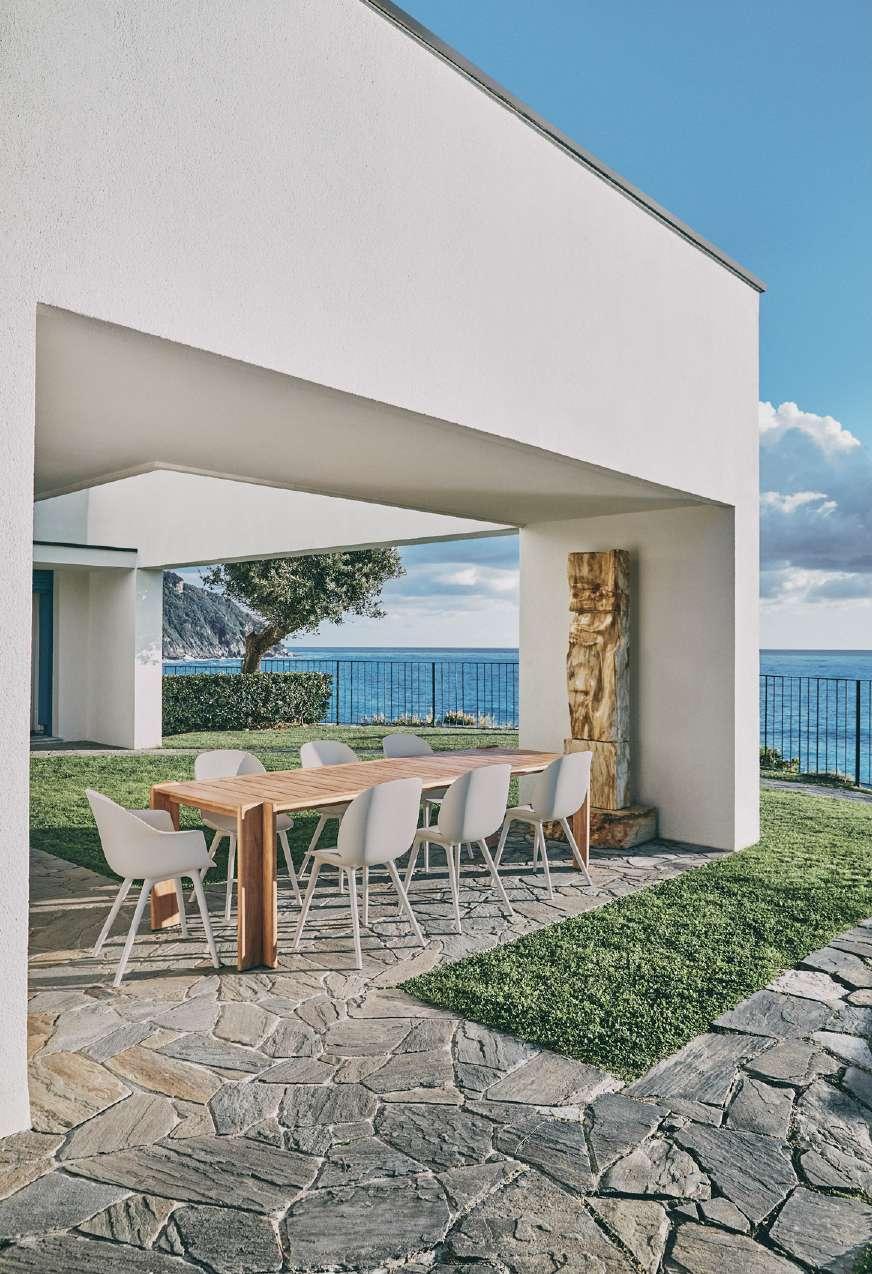

Born to a French father and a Swiss-German mother, Pierre Paulin (1927-2009) grew up in France, under the inspiration of his two uncles. His paternal uncle, Georges Paulin, invented the Eclipse mechanical folding roof system and, working with Peugeot, Bentley and Rolls Royce, provided a role model for creativity in business. His great uncle Freddy Stoll was a sculptor and instilled in a young Paulin the notion that an object should be beautiful from every angle.

Pierre studied in France – first ceramics in Vallauris and then stone-carving in Burgundy, intending to become a sculptor. Sadly, a severed tendon in his right arm put paid to his intentions to follow in his great uncle’s foot steps. He then enrolled at the cole Camondo design school in Paris, where a teacher urged him to join furniture designer Marcel Gascoin’s workshop. He served as an apprentice and learned his trade before travelling to Scan dinavia and the United States. He cited Ray and Charles Eames and George Nelson among his influences and, like Nelson, considered himself a func tionalist who added “two little drops of poetry” to his work.
Paulin went on to design his own furniture, stretching swimwear fabrics across chair frames – perhaps inspired by the cars his uncle designed. He embarked upon successful collaborations with Thonet and Artifort – the latter resulting in the Mushroom (1959), Tongue (1963) and Ribbon (1966) chairs, all of which have become sought-after classics. His low-slung fur niture provided a new laid-back perspective on life and his forward-look ing, eclectic and sculptural approach to design reflected the mood of the swinging 1960s.
Pierre Paulin’s first sketches for what would become the Pacha Collection were simple pencil outlines that resembled clouds. These forms became the basis for the Pacha Lounge Chair, defining a new spirit of the era. With out the constraint of legs, the Pacha heralded an era of low-level living, introducing a new way of lounging when it was launched in 1975. The he donistic, sinuous style of Paulin’s design attracted the patronage of French presidents Georges Pompidou and François Mitterrand, for whom he re decorated parts of the Élysée Palace. However, he was reluctant to build on this success – he refused to write marketing texts for the manufacturers to promote his products and wouldn’t dream of asking his influential patrons for influence or introductions.
When the industrial design firm that he and his wife, Maïa Wodzislawska-Pau lin, had founded in the mid-1970s was sold to a French communications agency (now Havas Worldwide), he retreated to the Cévennes mountains of southern France. He poured all his efforts into designing and building a country house and a landscape – the final masterpiece before his death in 2009 at the age of 81.


Before he died, Maïa Wodzislawska-Paulin, their son Benjamin, and Benja min’s wife Alice Lemoine – whose mother was a colourist for Paulin and a family friend – created a family enterprise called ‘Paulin, Paulin, Paulin’ to fulfil Paulin’s desire to see his unrealized designs put into production. It has since evolved into something with a bigger purpose – to win the man and his work the recognition he deserved within his lifetime but was too modest to pursue. Today, Kanye West, Nicolas Ghesquiere and Virgil Abloh figure among Paulin’s collectors and his designs can be found in contemporary art and design collections around the world, from the Museum of Modern Art, New York, to the Victoria and Albert Museum, London, along with the Centre Pompidou in Paris. His legacy has finally been assured.

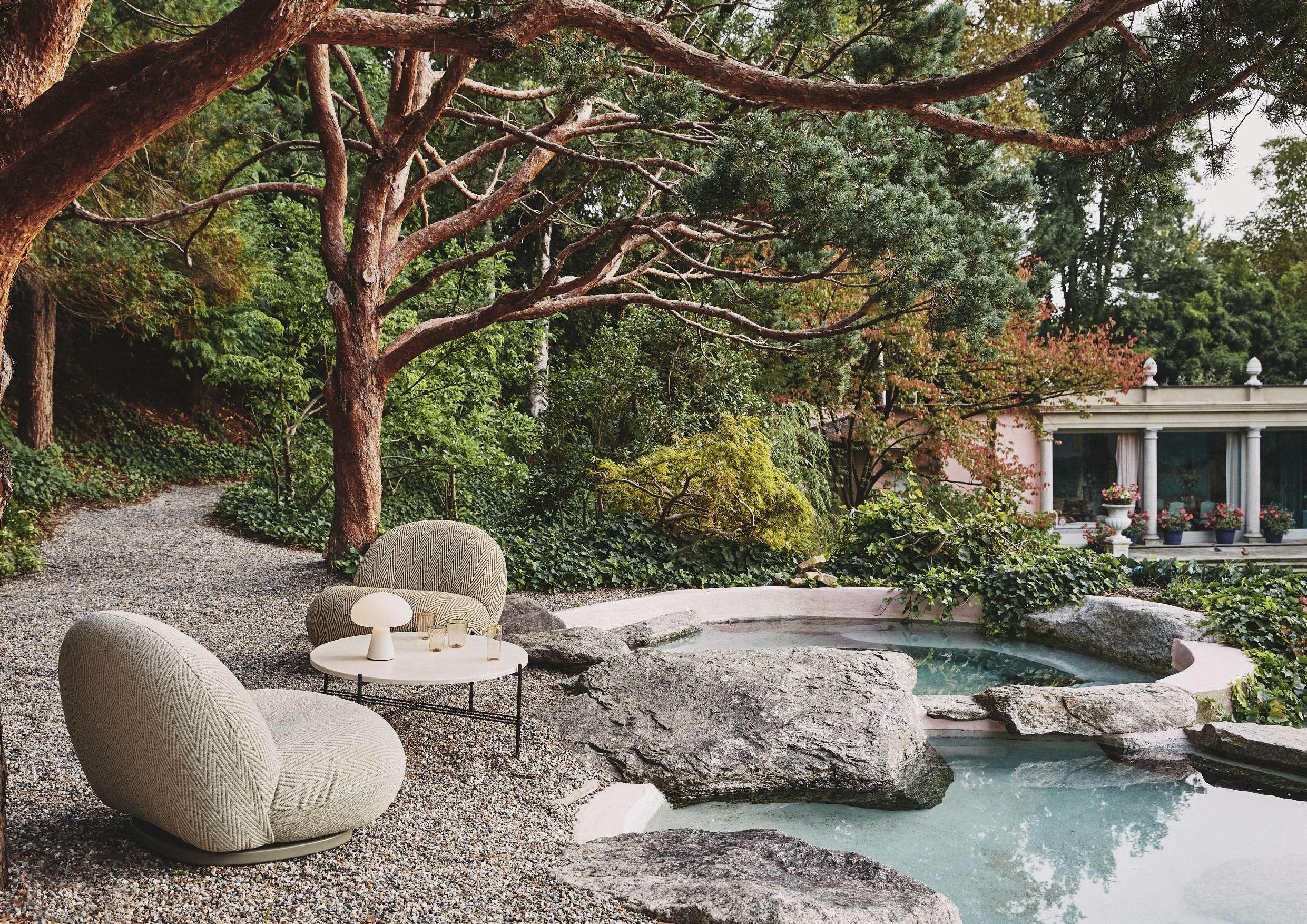 Pacha Outdoor Lounge Chair with swivel base TS Outdoor Coffee Table Ø80 Obello Lamp
Pacha Outdoor Lounge Chair with swivel base TS Outdoor Coffee Table Ø80 Obello Lamp
Breaking boundaries, Pierre Paulin’s pioneering seating con cept is moving outdoors. Enchanting exteriors demand ded icated seating to define spaces and create ambience. The sculptural softness of the Pacha Collection has always reward ed the sitter with a level of relaxation akin to sitting on the clouds that inspired it. Now the indoor collection’s signature comfort and distinctive aesthetics are available outside. Its low-slung typology – a rarity among outdoor seating products – is sure to make a statement.
Designed for durability, the Pacha Collection for outdoor fea tures a specially developed membrane interlayer that is both water-resistant and breathable to ensure quick drying after exposure to rain while maintaining the indulgent comfort of the iconic original. The base is made from moisture-resistant plywood to provide increased protection in humid conditions and includes a full swivel mechanism in stainless steel. A re movable rain cover offers further protection from the elements so, as soon as the rain clears, you can sit among the clouds once more.
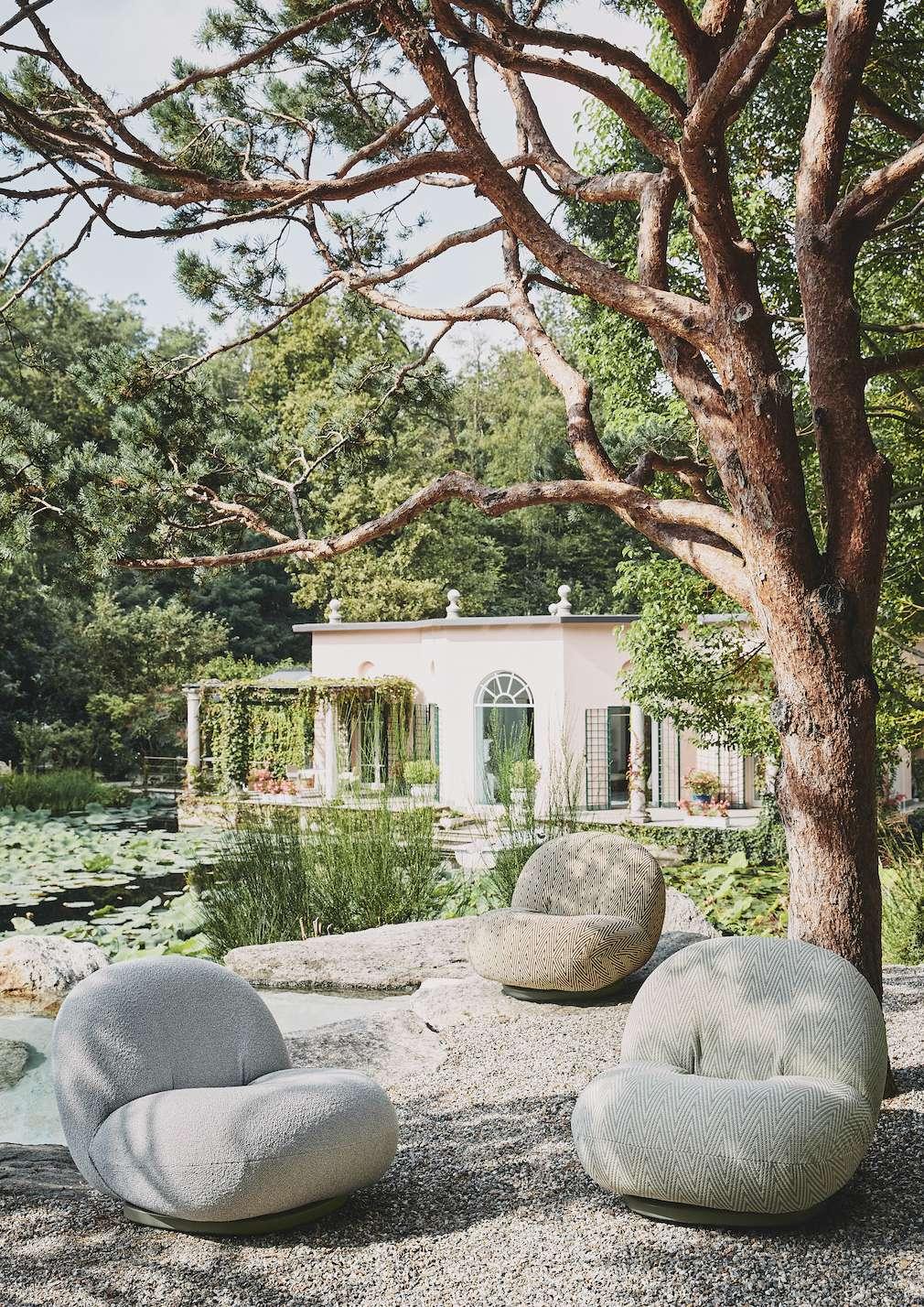 Pacha Outdoor Lounge Chair with swivel base
Pacha Outdoor Lounge Chair with swivel base
Left: Pacha Outdoor Six-Seater Sofa

Pacha Outdoor Lounge Chair with swivel base
Pacha Outdoor Ottoman
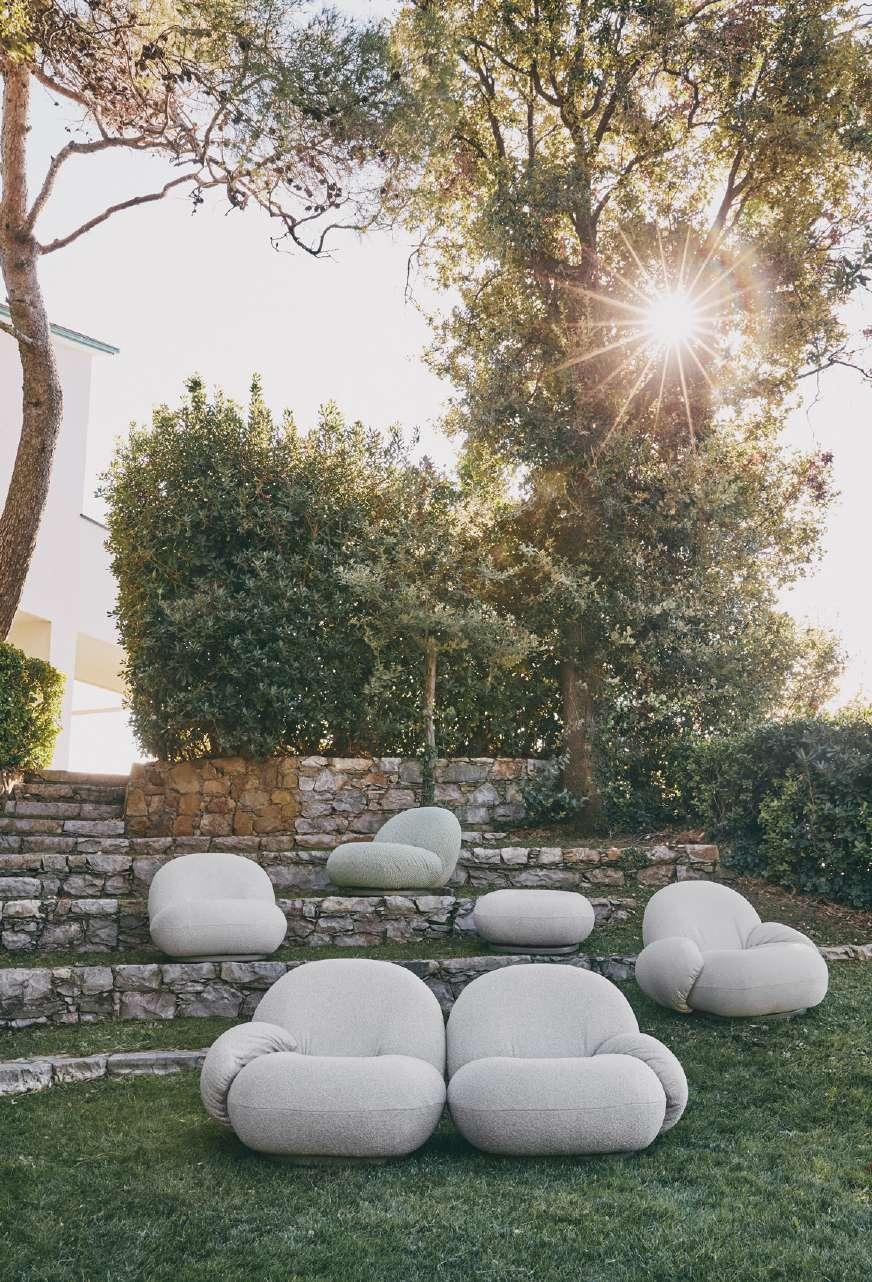
TS Outdoor Coffee Table Ø80
Right: Pacha Outdoor Lounge Chair with swivel base
Pacha Outdoor Lounge Chair with armrests and swivel base
Pacha Outdoor Two-Seater Sofa
Pacha Outdoor Ottoman with swivel base
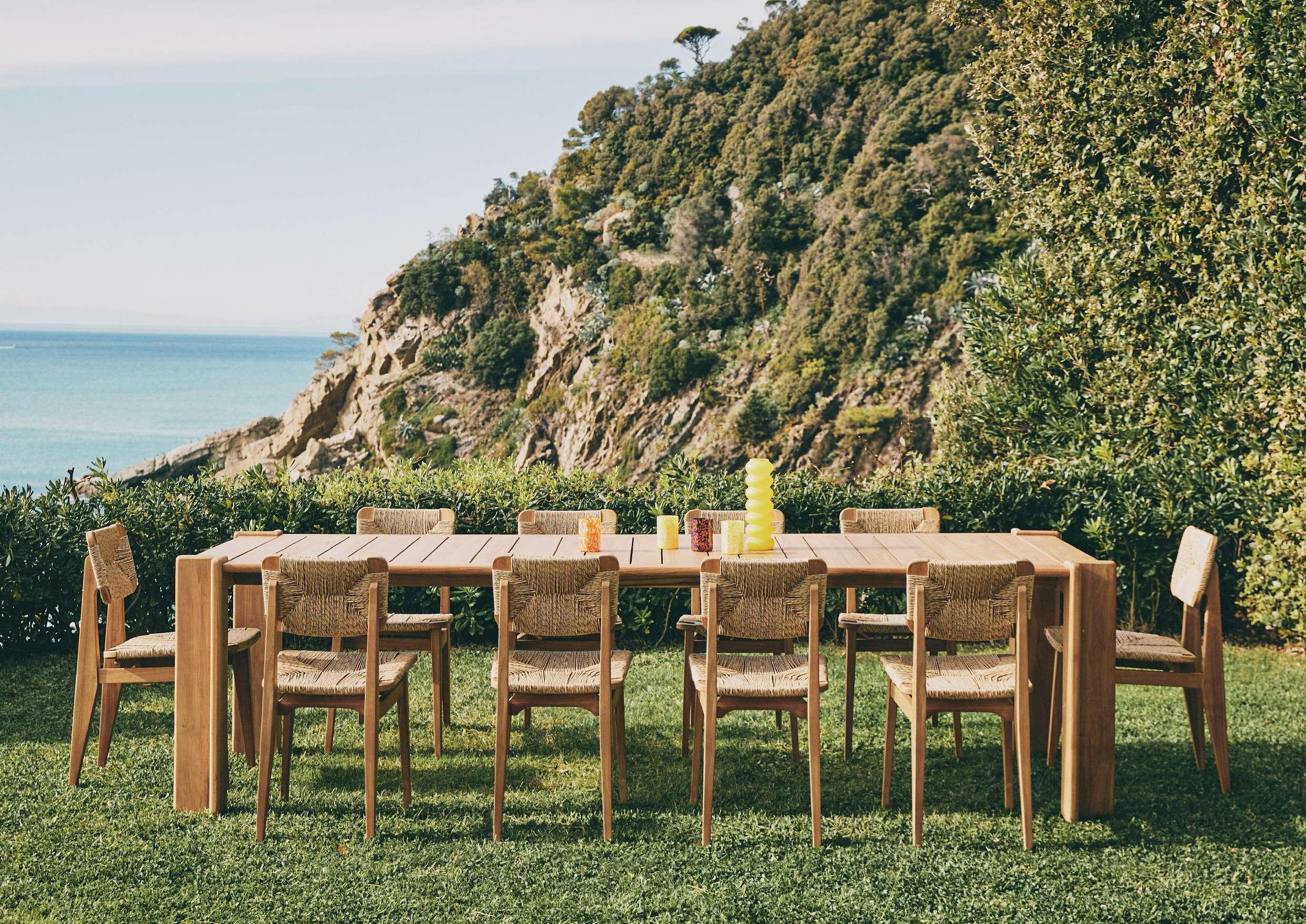
Best known for collaborating with contemporary designers and reviving archival pieces, GUBI’s Mi lan- based design studio has created an outdoor table collection with the mood-setting title, Atmos fera. Comprising a dining table in two sizes and a coffee table, the collection has been conceived to bring an unique vibe when gathering outside for al fresco dining and lounging. The Atmosfera Col lection represents the attention to detail and quiet elegance that characterizes GUBI.
The tables’ simple aesthetics maintain an un derstated poise with a nod to classic references without being too formal. The tabletops are made from rhythmic, repeating slats of solid, premium teak, enclosed by a frame made from the same slats, giving a minimalist feel. The table legs are formed from two vertical slats, using a miter joint that creates an inverted ‘L-shape’ on each corner. Referencing architectural and maritime design, the unusual leg design provides both structural sup port and visual interest, giving the piece a certain lightness. Each leg protrudes slightly above the tabletop surface, culminating in a rounded detail in contrast to the geometric lines of the structure, that gives a calm composure to the design.
Both dining tables – one to seat six and the other to seat eight – and the coffee table follow the same design, with considered differences in dimensions to reflect their functionality. Their calm and linear style links, accompanies and supports the iconic and eye-catching pieces in the GUBI Collection for outdoor. With generous leg clearance, the At mosfera Dining Tables pair particularly well with outdoor variants of the C-Chair, the Beetle and Bat Chairs and the Tropique Chair. The Atmosfera Coffee Table is the perfect partner for the outdoor Pacha Collection.
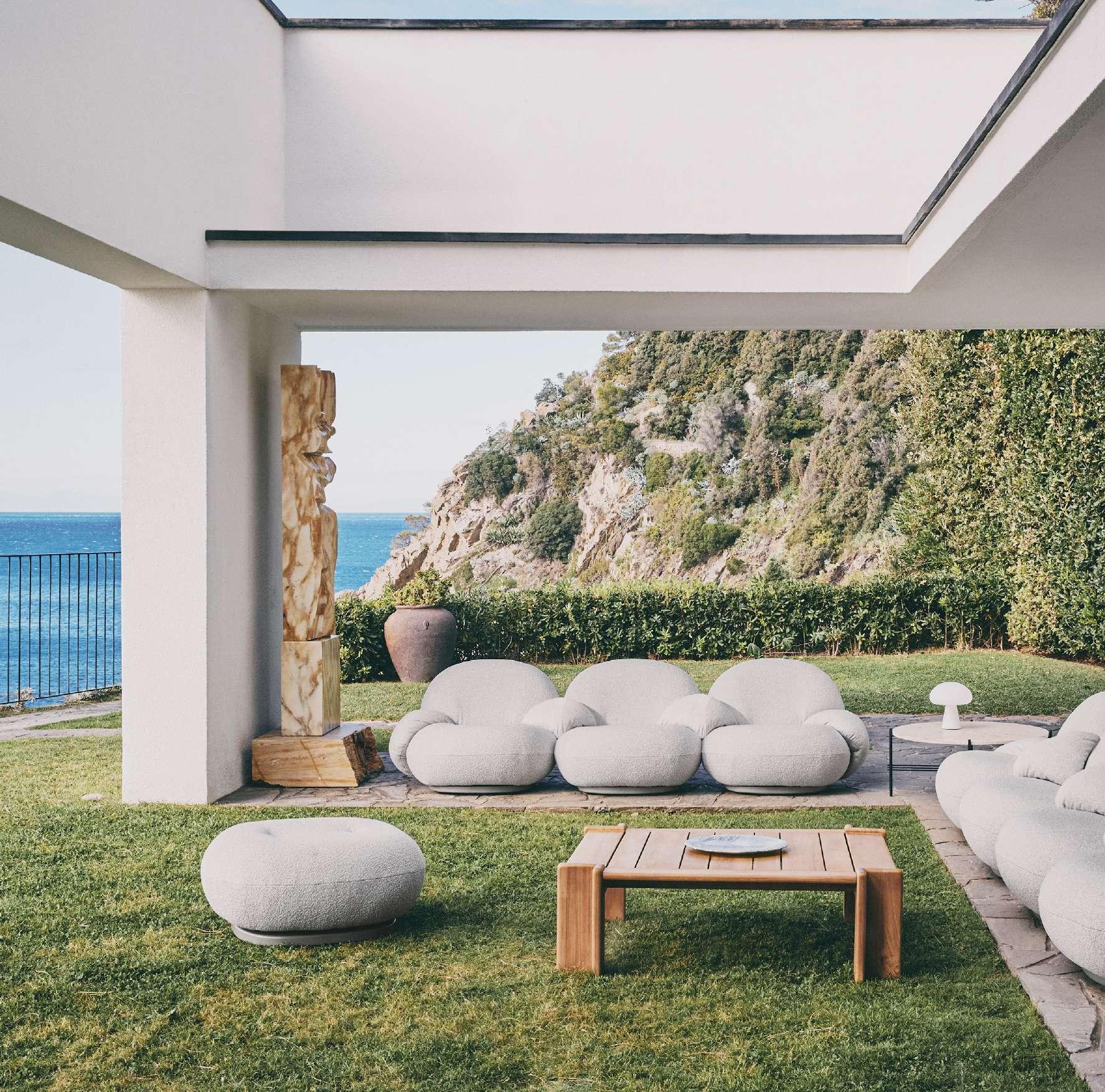
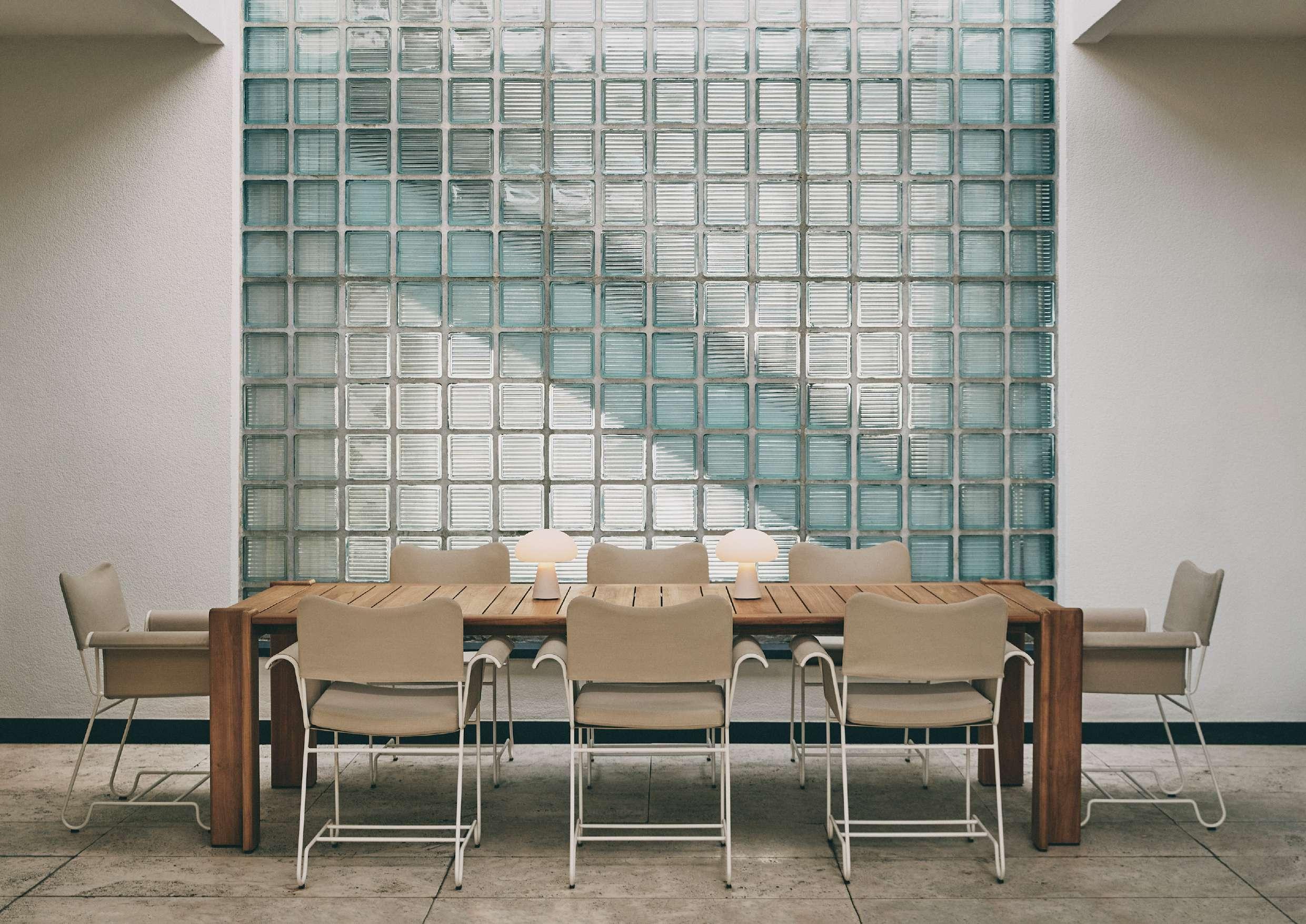 Atmosfera Dining Table To Seat Eight People
Tropique Dining Chair
Obello Lamp
Atmosfera Dining Table To Seat Eight People
Tropique Dining Chair
Obello Lamp
Using teak as the only material enables the tables to define spaces within diverse indoor and outdoor environments. From an arid Mediterranean garden to a lush tropical backdrop or a Nordic fjord deck, their tactile construction blends well with any natural surroundings. Teak's high tensile strength and tight grain make it an excellent structural timber and a high-quality furniture wood. It is also rich in naturally occur ring oils, which make it inherently resistant to the effects of weather and natural wear and therefore particularly suitable for outdoor furniture. GUBI’s teak is buffed, bringing the natu ral oils already contained within the wood to the surface, and burnished to produce a rich sheen and a consistent color.
The tables can be left outside, uncovered, and untreated all year round, and will fade to a beautiful and even silver-gray patina with a characterful, slightly raised, texture over time. For those who wish to preserve the wood’s honey-gold tones, an annual application of oil or sealant is a simple solution –alternatively the tables can be flat-packed for winter storage.
The Atmosfera Collection only uses farmed plantation teak with SVLK certification, which ensures biodiversity, sustain able forestry practices, and provides additional economic benefits to the local economy. The tables pack flat for efficient transport and are made from wood only, which avoids extra processes and materials, such as metal or powder coating.
Teak wood consists of heartwood which comes from the cen ter of the trunk and is the most desirable and best-performing wood of the teak tree. The heartwood is what is used by furni
ture makers – it has a leather-like scent when newly sawn and its initial yellowish color quickly darkens to its characteristic rich brown hue.
The heartwood is rich in naturally occurring oils, which make it inherently resistant to the effects of weather, insects, rot, fungi and mildew, and therefore particularly suitable for out door furniture. Its natural oils prevent it from warping, crack ing or becoming brittle. The fact that its natural oils remain locked in the wood mean that teak is one of the most durable and long-lasting of all hardwoods, even if left uncared for. In parts of Western India, teak objects have been found intact that date back over 2,000 years.
Teak, or ‘tectona grandis’ to use its Latin name, originated in India, Myanmar and Laos and ancient teak forests can be found across south and southeast Asia, with Myanmar’s forests still accounting for almost half the world’s naturally occurring teak. Teak plantations were established in India, In donesia, equatorial Africa, and the Caribbean in 19th century. Teak was first introduced to the Western world when sailors and traders visiting India and China in the early 1800s were impressed by the wood in widespread use as a boatbuilding material. Teak has been used to make ocean-going vessels for more than 2,000 years and it continues to be used in the construction of ships and high-end yachts to this day. It was only in the 1950s that it was introduced to America, and later to Europe, when it quickly became a popular choice for out door furniture.


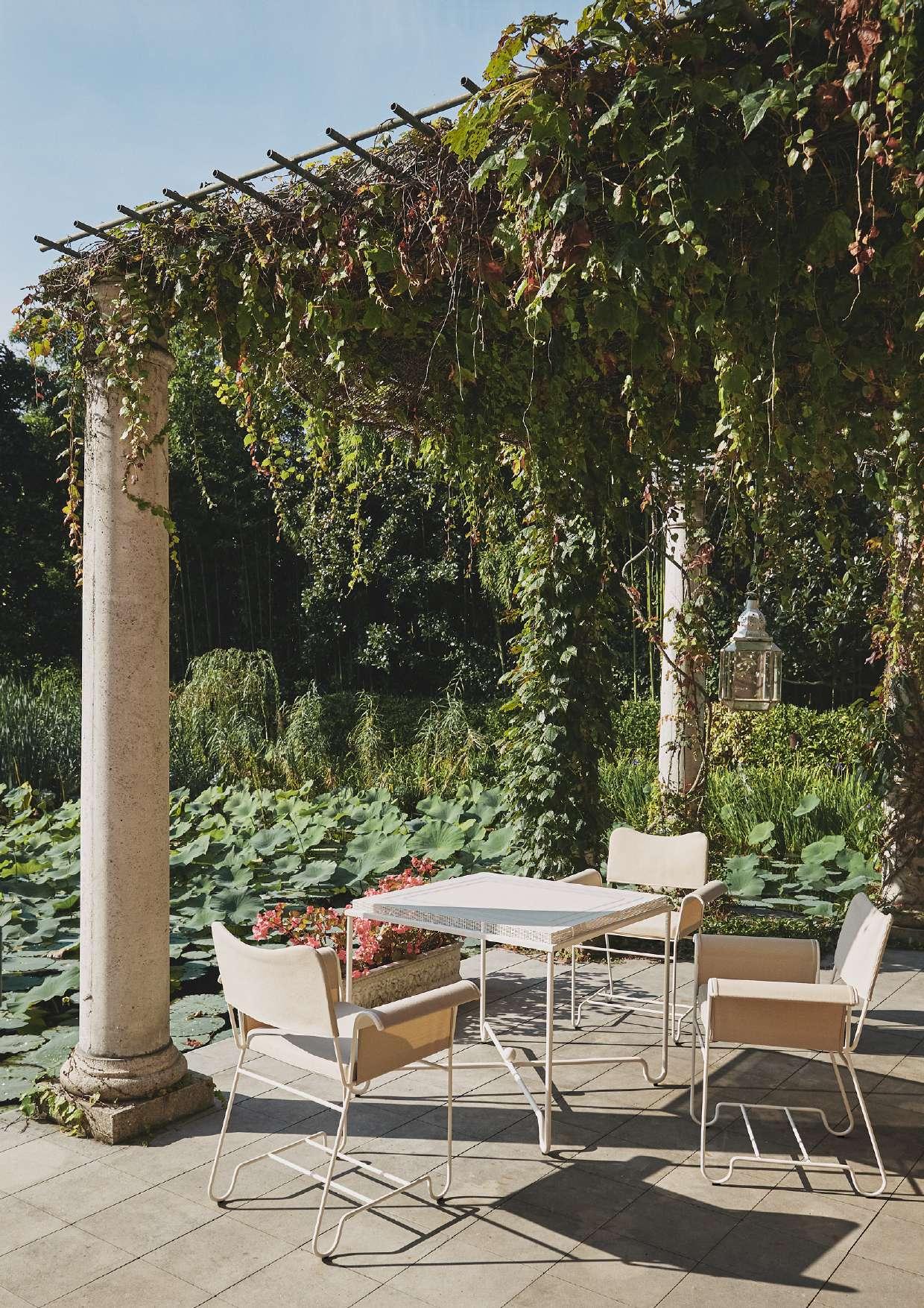
Mathieu Matégot (1910–2001) was a versatile, independent and self-taught Hungarian designer, architect and artist who spent most of his life in his beloved Paris, where he settled in 1931 after travelling to Italy and the United States, studying at Budapest’s School of Art and Architecture and gaining experience in set design, window dressing, fashion, and tapestry. In 1939, Matégot volunteered for the French army but was captured and held prisoner in Germany until his escape in 1944. Matégot’s wartime captivity was important to his later career, as it was here that he first learned about the techniques and potential of sheet metal while working in a mechanical accessories plant.

After the war, Matégot established a furniture workshop, ini tially in Paris and later in Casablanca, using materials such as rattan, glass, and Formica, but he is best known for his own ground-breaking material and technique, which he named Ri gitulle, made from perforated sheet metal. Like fabric, Rigitulle can be bent, folded and shaped, giving the furniture and home accessories he designed transparency, weightlessness and enduring modernity. Matégot patented this material and tech nique and set up his own production so that he could apply it to his designs. He applied his inventive approach across a range of household objects from fruit bowls, lamps and coat racks to an extensive furniture collection including drinks trolleys and two inspired interlocking shelving systems. His three-legged Nagasaki Chair (1954) and his Copacabana Lounge Chair (1955), both made of steel tube and perforated sheet metal, are now held in the design collections at Paris’ Musée des Arts Décoratifs and Centre Georges Pompidou respectively.
Like many of his peers, Matégot travelled the world in search of inspiration and, upon his return, transformed the industri al processes and aesthetic impressions he had collected into his own unique designs and interpretations. Throughout the 1950s, he devoted himself to the design of furniture and in terior accessories, creating an impressive array of distinctive furniture and home accessory designs that still resonate with contemporary audiences and are now considered iconic. To
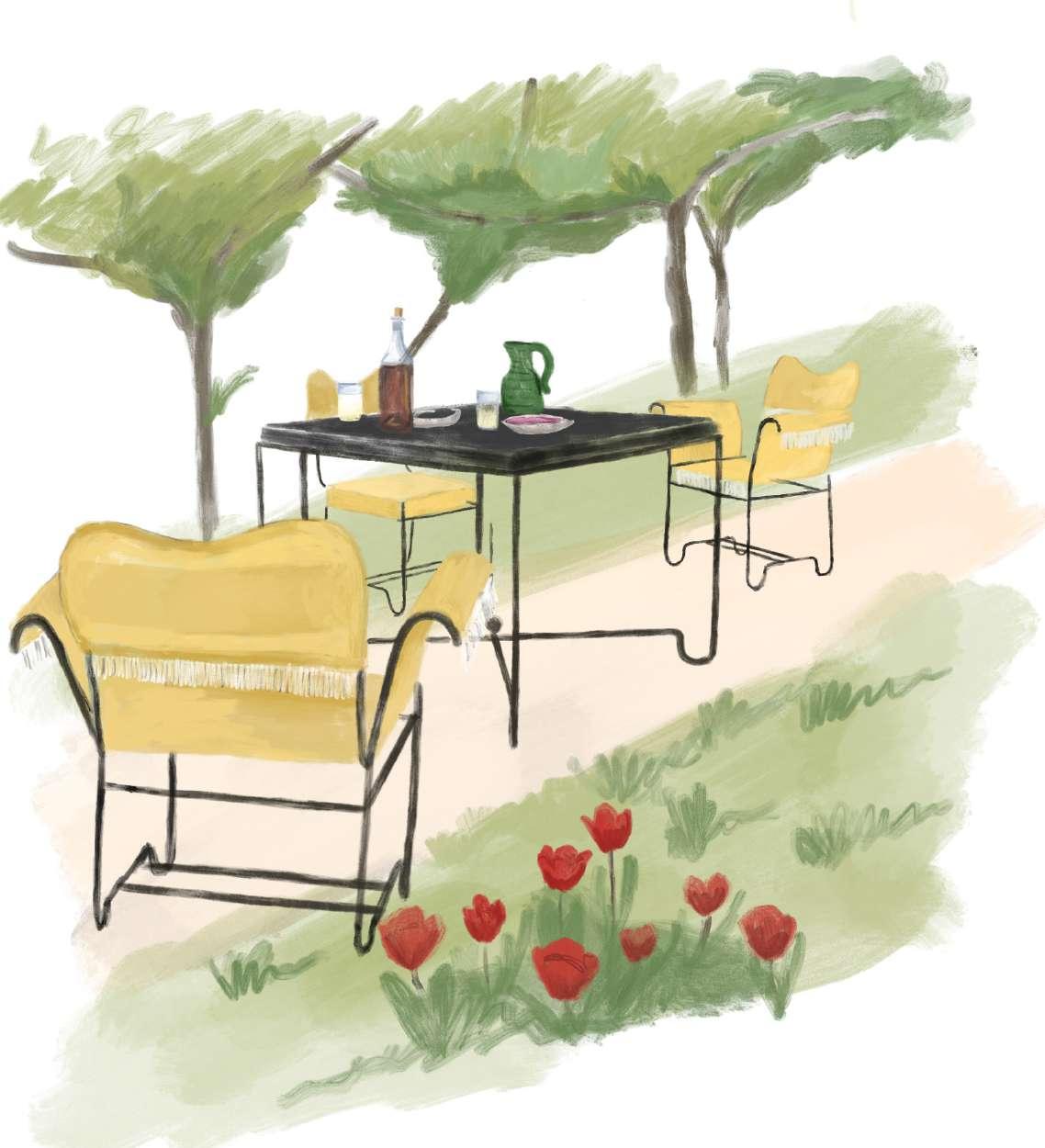
ensure quality in the production of his designs, Matégot manu factured in limited numbers of up to 400 in his own workshops in France and then Morocco. Production continued until the beginning of 1960s when he left furniture design to devote him self full-time to his tapestry work, which he would continue for the rest of his career, becoming one of the preeminent artists within French modern tapestry.
More than five decades after it was first designed and 20 years since the death of its designer, GUBI is proud to pay homage to Mathieu Matégot with the relaunch of one of his most popular collections. Out of production for decades, the Tropique Col lection has been revived by GUBI for the 21st century, giving a new generation a chance to live ‘la dolce vita’ as Mátegot imagined it.
Developed soon after Matégot had returned from WW2 and set up his furniture workshop in Paris, Tropique was one of four key collections that established his reputation as a designer. The curvaceous forms won the attention of some of the most pres tigious design publications of the day and earned him a place at some of the most important events and exhibitions of his time. One such exhibition, Art & Decoration’s 'La Fleur dans la Maison’ in 1950, showcased the Tropique Collection immersed in tropical flora, brilliantly demonstrating the design’s affinity with the natural world and the al fresco lifestyle.
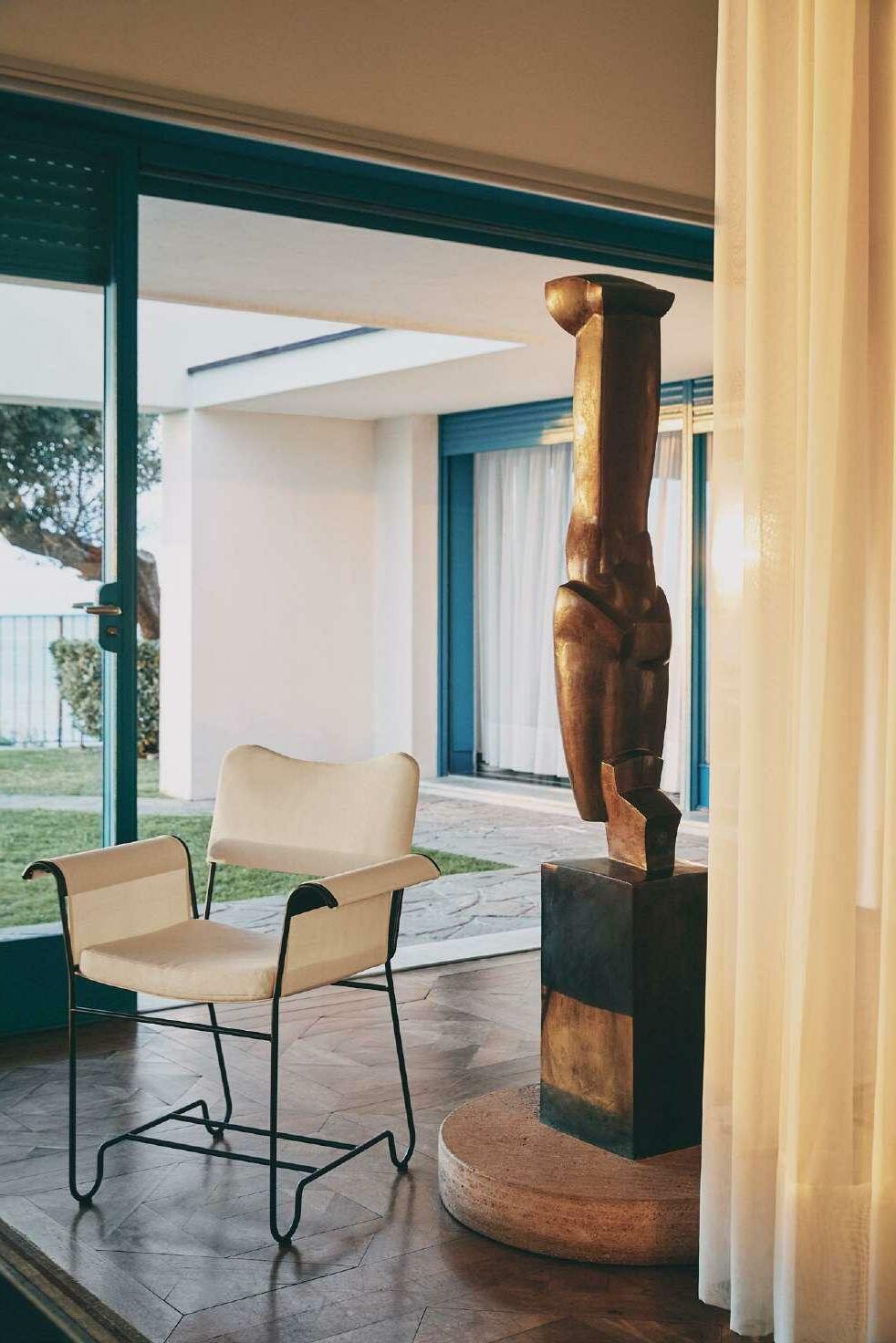

Created in the 1950s, the Tropique Collection of outdoor fur niture captures the timeless glamour and exotic luxury of out door living on the Côte d’Azur in the mid-20th century. Com bining material simplicity with a decadent aesthetic, Tropique comprises two dining chairs and a dining table. The frame of each piece is made from stainless steel rods, incorporat ing a distinctive statement curve at the feet – a signature of Matégot’s style and a feature that unites the collection into a clear and cohesive whole.
To give his furniture a balance of strength, durability, and apparent weightlessness, Matégot frequently turned to per forated metal as a material choice, taking advantage of the fact it could be bent and shaped like fabric, resulting in light weight, transparent surfaces. To create the Tropique Dining Table, a stainless steel sheet is pressed and welded onto the frame, providing a solid, functional surface that allows sun light to pass through.
Tropique Dining Chairs’ seats and backrests are today made from a durable yet gently flexible outdoor fabric that is at tached to the underside of the curved armrests by a series of pins. This is a contemporary evolution of Matégot's initial construction whereby the fabric was woven through holes in
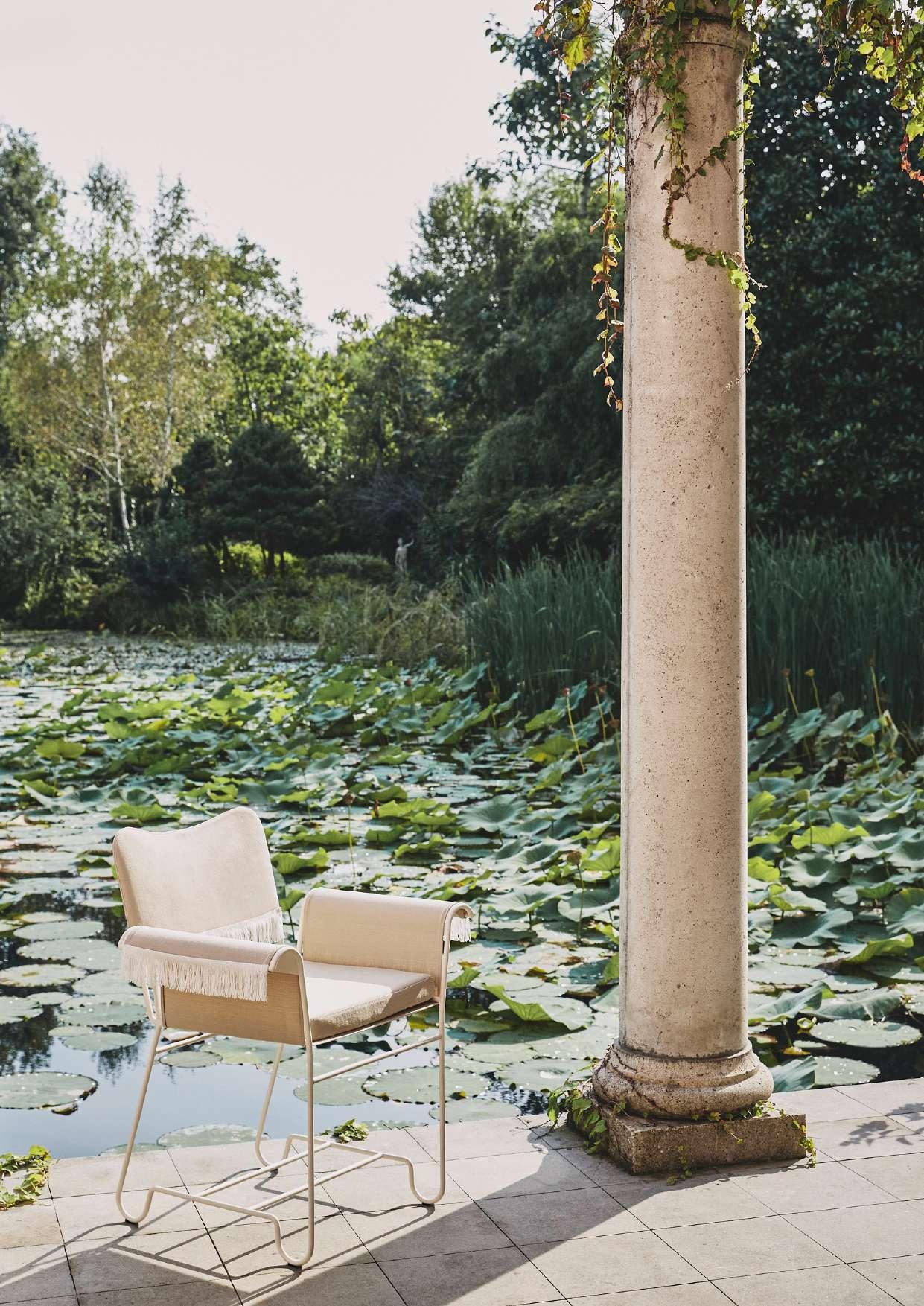
the metal. This maintains the look of the original design while allowing the upholstery fabric to be easily exchanged. Hung in a hammock-like manner across the frame, the textile seat responds to the contours of the body. The backrest is padded with foam instead of the original horsehair and a loose pillow added to the seat ensures optimal comfort.
The Tropique Dining Chair is available with black or off-white powder-coated frames, for durability outdoors, and two up holstery options. The option of adding tasseled fringes to the arms, seat, and backrest introduces a note of playfulness perfectly in keeping with the design’s laidback poolside char acter. Matégot’s assured used of textiles in this collection offers a hint of his later career, as, having found internation al success as a furniture designer, he moved on to become equally influential as an upholsterer.
Of all the iconic designs conceived by Mathieu Matégot during his career, Tropique is among those that he loved the most, having chosen it to furnish his own apartment. Re stored and updated, GUBI’s revival of the Tropique Collection is a timely tribute to one of the most important and distinctive French designers of the modern age and the natural way to celebrate his legacy.
Tropique Dining Chair With FringesLeft:
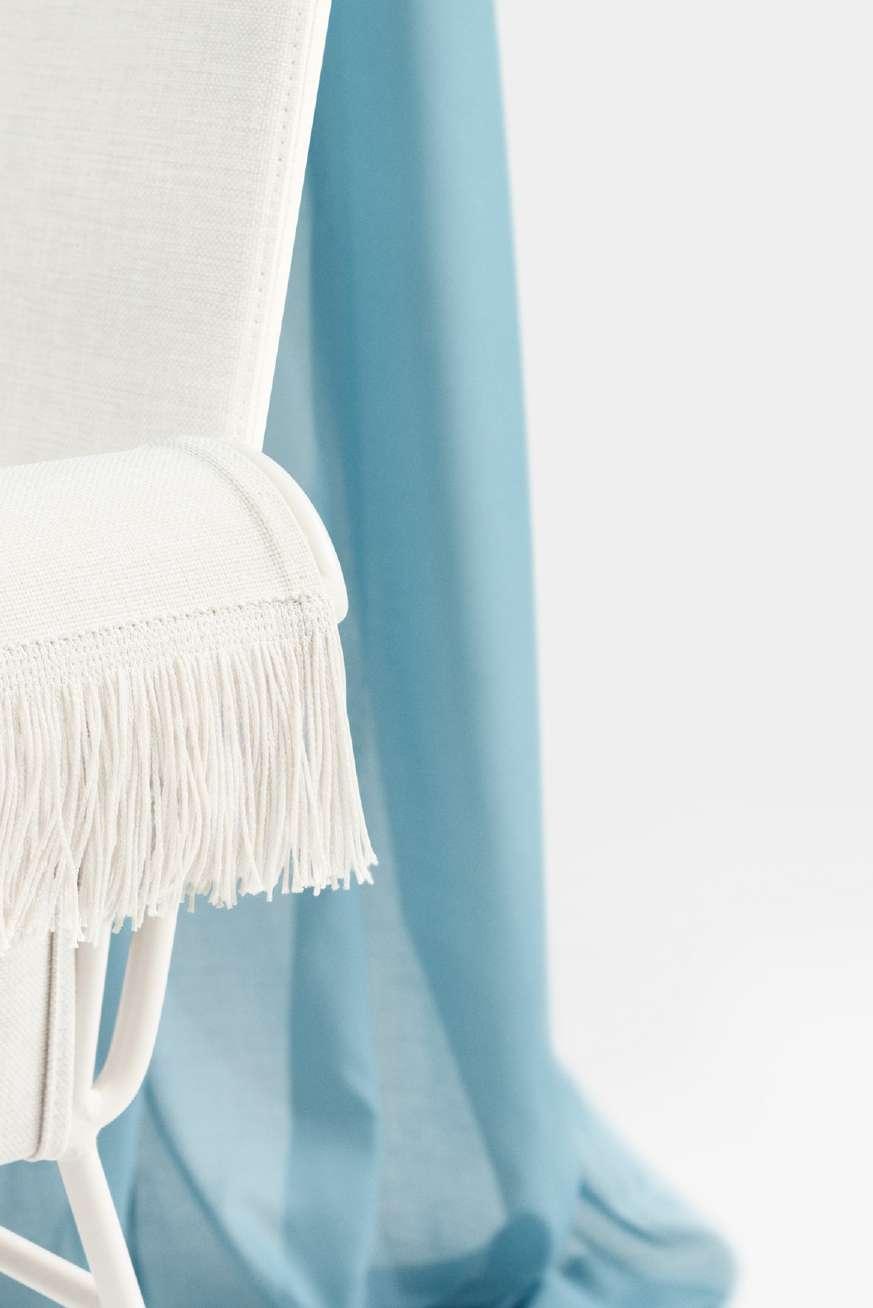
Right:
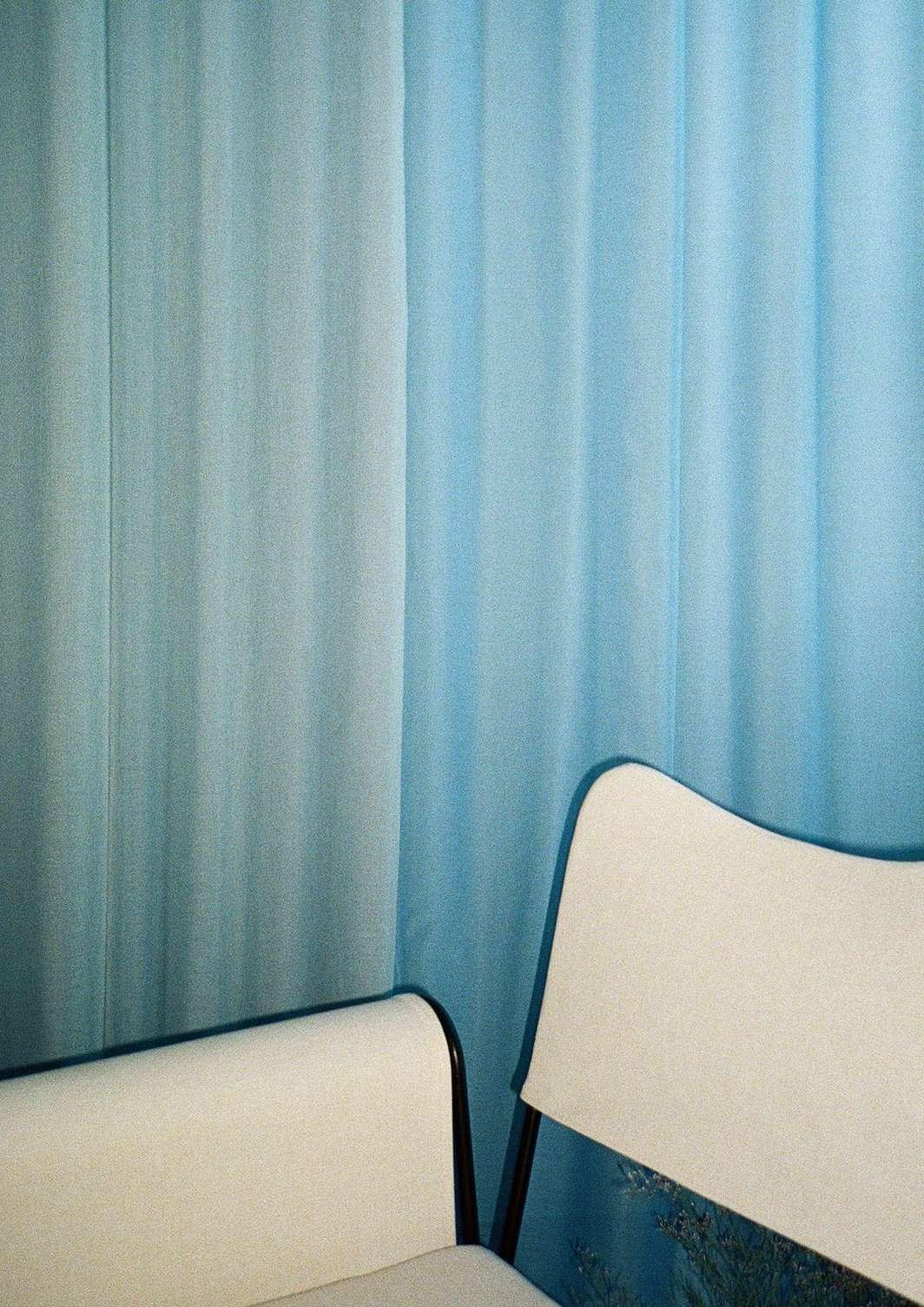 Tropique Dining Chair
Tropique Dining Chair With Fringes
Tropique Dining Chair
Tropique Dining Chair With Fringes
BOHEMIAN 72 LOUNGE CHAIR
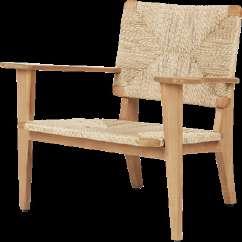




C-CHAIR OUTDOOR DINING

BOHEMIAN 72 SOFA
F-CHAIR OUTDOOR LOUNGE
BOHEMIAN 72 OTTOMAN
BOHEMIAN 72 FLOOR LAMP

OBELLO LAMP
TS OUTDOOR COFFEE TABLE Ø80

TS OUTDOOR SIDE TABLE Ø40
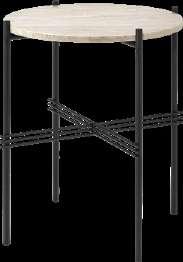
PACHA OUTDOOR LOUNGE CHAIR WITH SWIVEL BASE
PACHA OUTDOOR THREE-SEATER SOFA WITH ARMRESTS
PACHA OUTDOOR LOUNGE CHAIR WITH ARMRESTS AND SWIVEL BASE
PACHA OUTDOOR FOUR-SEATER SOFA WITH ARMRESTS
PACHA OUTDOOR OTTOMAN WITH SWIVEL BASE
PACHA OUTDOOR TWO-SEATER SOFA WITH ARMRESTS
PACHA OUTDOOR LOUNGE CHAIR / SOFA MODULE COVER

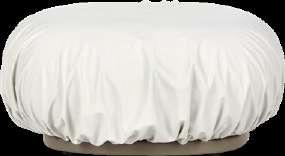

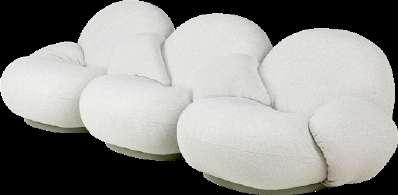
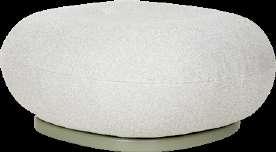
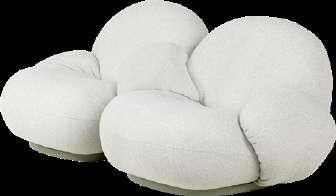

PACHA OUTDOOR OTTOMAN COVER
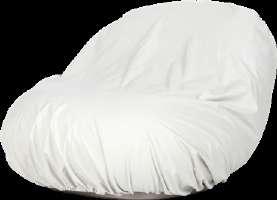
ATMOSFERA DINING TABLE TO SEAT EIGHT PEOPLE
ATMOSFERA DINING TABLE TO SEAT SIX PEOPLE
TROPIQUE DINING CHAIR
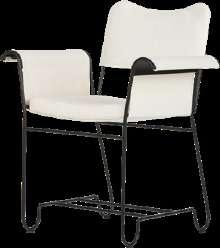
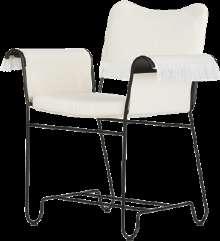
TROPIQUE DINING CHAIR WITH FRINGES

ATMOSFERA COFFEE TABLE
TROPIQUE DINING TABLE
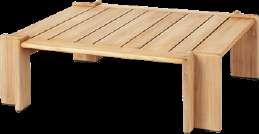
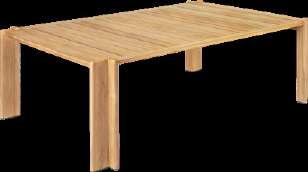

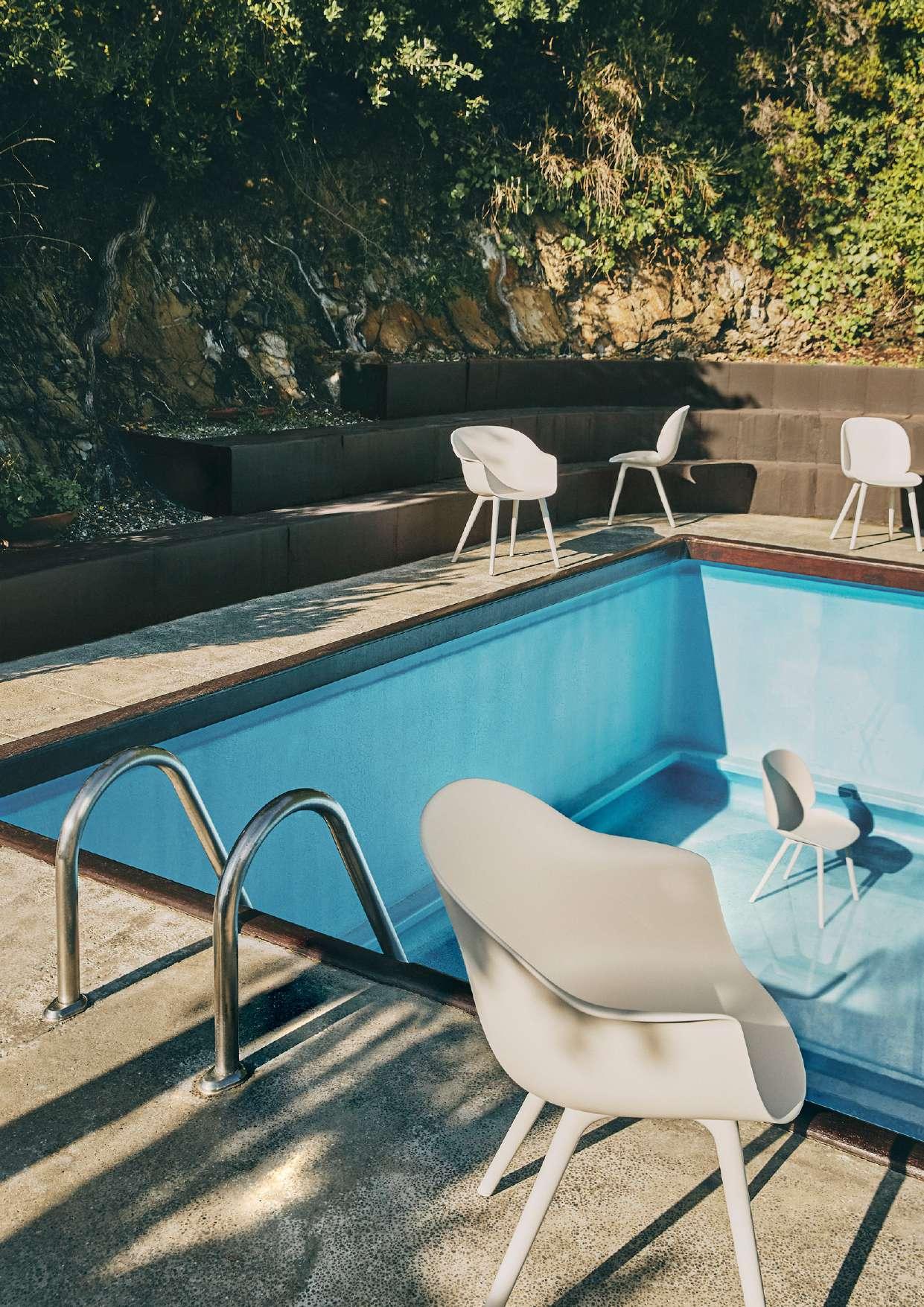
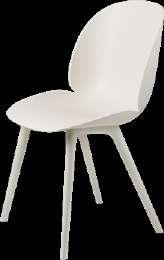

Open up. Let the world in. Discover the spaces of your life.
Where indoors can be outdoors, where personal can be social, where you can set the scene, show your passion, be yourself.
Shape the outdoors, and let the outdoors shape you.
This is my mirror, my chandelier, my spectacle. This is where we sit, where we laugh, where we become inspired. A living, breathing room – always in transition, always full of life.
This is our backdrop, the big reveal, with a place for everyone – every day.
From before dawn until beyond dusk, for every moment, a space for change, a space to dream, a space to be present.
This is our stage for a thousand memories, the start of our greatest adventures, our journey outside.
GUBI goes al fresco. 2022
